GURPS Technomancer by Fossilized Rappy
Introduction: What the Hell am I Looking at Here?
Original SA post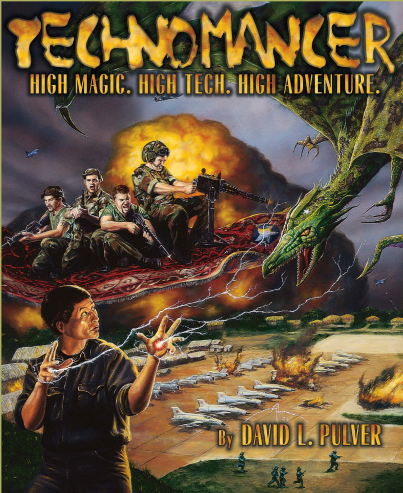
And lo, did Steve Jackson Games say "make something that would be kicking rad to airbrush on the side of a van." And it was so, and it was good.
I decided that with the way this thread moves compared to my actual moments of "feels like engaging in active output", it wouldn't hurt to do two reviews at once. Especially when I'm going to be in the Exodus mines for two more books (three if I decide to do the new Game Master's Guide they put out recently). So, here we are, and a shout out to the Goon who requested someone review GURPS Technomancer in the first place.
Introduction: What the Hell am I Looking at Here?
Published in 1998 by Steve Jackson Games (of course, given that this is GURPS we're talking about), GURPS Technomancer was written by freelance writer and frequent GURPS contributer David L. Pulver. Pulver is probably the quintessential example of "mad genius": capable of creating lots of really creative and interesting concepts, but also eccentric as hell. His two big loves are science fiction and anime, the former being outwardly shown in his creation of the GURPS setting Transhuman Space and the latter in the fact that sex droids and catgirls are frequent features of most books he writes. For those with weak anime constitutions, I will give the forewarning that GURPS Technomancer has both in brief quantities.
Anyway, Technomancer is set in the then-present of the 1990s, but one that diverged at the end of World War II thanks to the atomic bomb being linked to a magic ritual that would bring the paranormal into the mundane world. The result is a timeline where the Vietnam War was won by zombies, golems, dragons, and flying carpets being used by the American forces, nuclear technology is highly tied to magical formulae, and wizards got us into space. The "modern day" is a similarly twisted mirror of familiar 90s topics such as big corporations, Greenpeace, the Irish Republican Army, Hezbollah, and the Weather Underground being contrasted with factory line magic items, fast food made even faster with the use of cooking spells and enchanted tools, dragon CEOs, and sapient communist penguins.
In between every Exodus review, I'll be looking at GURPS Technomancer and Funny New Guys, a sourcebook for playing Technomancer during the Vietnam War. I'm far more familiar with GURPS Fourth Edition than I am with its predecessor, but I'll try to do my best to avoid any fuckups concerning discussion of mechanics meeting fluff and the like.
Oh, and this intro post doesn't count for moving immediately back to Exodus. We'll definitely be looking at chapter 1 of GURPS Technomancer before we get back to that!
Chapter 1: History, Chapter 2: Magic
Original SA post
Chapter 1: History
"Now I am become Death, the destroyer of worlds." The words of Krishna, avatar of Vishnu, as he unveils his incomprehensible deific form to Prince Arjuna in the Hindu scripture of the Bhagavad Gita, purportedly went through the mind of Julius Ropert Oppenheimer at the testing of the atomic bomb near Alamogordo, New Mexico. In the world of Technomancer, whoever, they were not just thought, but spoken, and to immense results. The recital became the incantation for a necromantic ritual that helped the power of the nuclear blast rip a hole straight through the fabric of space-time. The rift spun with a terrifying tornado of magic, lightning, and atomic fire that has become colloquially known as the Hellstorm. While rather terrifying to behold and rendering the area irreparably inhospitable, the US made lemons into lemonade and used the Hellstorm as a political weapon against Japan. No need to drop two more atomic bombs when a nightmarish funnel of death has already permanently scarred a point on the planet and can be readily pointed to as an example of what the atom bomb could accomplish.
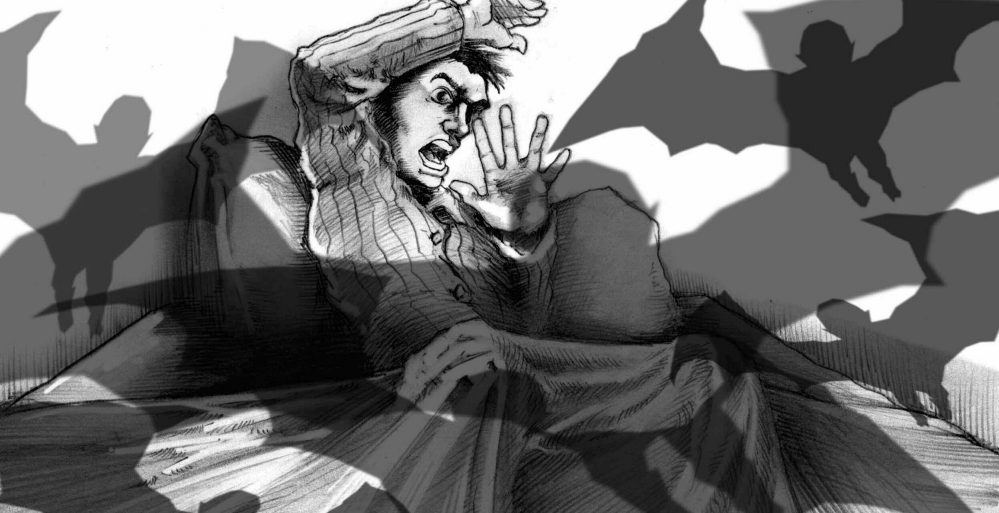
The end of World War II would be just the start of the big deal repercussions of the Trinity event, though. Within a year came the result of the "mana particle fallout" washing over the planet. Babies began to be born with inhuman features, stillborn infants rose from the grave to feast on the blood of the living, strange animals and weather phenomena started appearing in the American Southwest...oh, and people who claimed to be able to do magic even before the event were suddenly able to back up their claims, that's probably a big one to note. Believers in ceremonial magic and supernatural religious rituals, as well as self-proclaimed psychics, were all showing off actual, demonstrable, and most of all repeatable paranormal abilities. And with the promise of repeatable results came massive amounts of research and military probing into just what made mages tick. Projects Fafnir and Sinbad were launched in 1948, black ops projects to breed Army-loyal dragons and create levitating devices respectively.
Meanwhile, the USSR, being the USSR, attempted to replicate the effects of the Trinity nuclear tests with its own atomic bomb in 1949: the Zhukov 3, which was detonated beneath the ice sheets of Antarctica. Whatever the intended result, the actual results were far more terrifying, with a Hellstorm 32 miles wide enveloping a chunk of the Antarctic continent. This massive increase in magical energy – dubbed as "Oz particles" in 1960 – not only affected the local wildlife, it also further unbalanced the fabric of reality. Modern estimates suggest that even one more nuclear bomb could irrevocably break the remaining fabric and make known physics go from bendable to utterly non-governing. his fact, to say the least, has been one hell of a backer for the nuclear non-proliferation treaty.
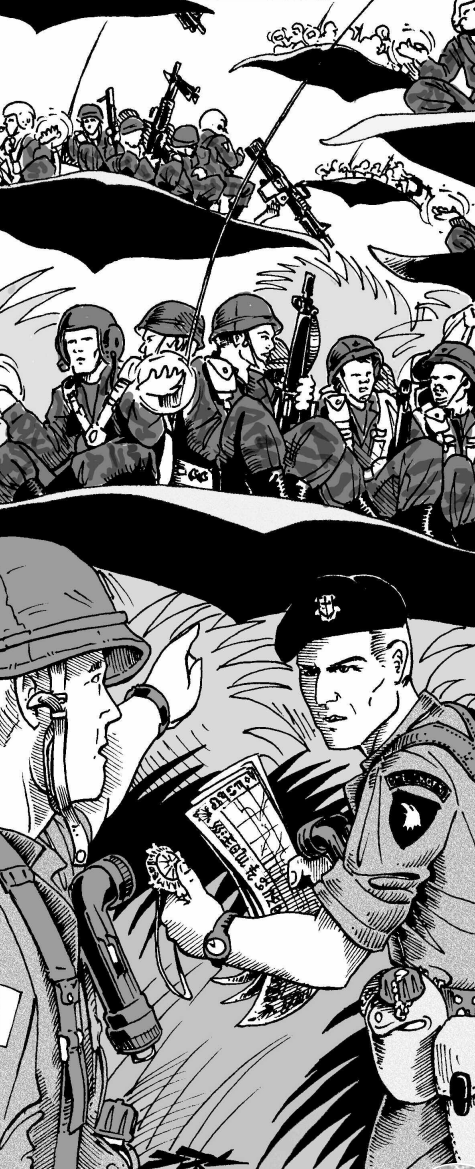
The rest of the paragraphs of text mostly concern the Cold War. The USSR and its allies in Cuba terrified the United States with increasing magical capabilities, and even the staunchest members of the religious right ended up having to concede that it would be stupid to avoid spreading magery talents throughout the American populace. The resulting rush of technomagic came to be known as the Third Industrial Revolution and could be seen everywhere from the military and collegiate institutions down to everyday homes utilizing magic items enchanted by factory line wizards. Even counterculture got in on the act: one particularly successful group were the Agrarian Conspiracy, a clan of neo-Luddites who saw magic as the perfect excuse to go Amish in the most convenient and successful way possible.
In addition to this overview of major events early on in the history of GURPS Technomancer's world, there is also a complet e timeline from 1945 to 1998. While it would be a folly to note every single date, it would be a crime to not at least convey some of the most
 ones on the list:
ones on the list:
-
In 1954, demons are spawned from the Nevada Test Area and go hog wild attacking the crew of the infamous Genghis Khan flick
The Conqueror
. John Wayne, apparently actually some kind of gunslinging badass in this universe, dies fighting off the otherworldly invaders.
-
In 1962, the couple Betty and Barney Hill claim to have been abducted by otherworlders that call themselves the Seelie faeries. This is the first of many cut-and-paste references to UFO lore with faeries replacing extraterrestrials.
-
In 1963, Lee Harvey Oswald kills JFK with a magic bullet. A literal one, of course.

-
In 1969, the Manson family summons an assload of demons to help continue their murder spree more efficiently. They fight the FBI for three days in a massive magical duel.
-
1981 sees two big events. On the dark side, Iraqi wizards murder Kurds and Iranians with summoned demons. On the light side, filmmaker Steven Spielberg creates an overwhelmingly popular heart-warming family film called Seelie, which is about an elf who is helped back to the Otherworld by a kindly human boy.
-
In 1982, the Falklands War takes a grim turn as Argentina calls forth the ghosts of U-Boats and their crew (yes, objects can have ghosts) to beat the shit out of the British Royal Navy.
-
In 1987, popular televangelist Bob Leaman is involved in a scandal when it turns out he has been having sex with a succubus.
-
In 1992, after decades of plotting and planning, an army of sapient communist penguins ousts humans from Antarctica entirely.
- In 1997, Stalin rises again! Or gets woken up, at least. Turns out that he was secretly put in suspended animation until better medical magic could turn him from a dying old man into a statuesque god-king. This unexpected turn breaks Russia into a messy civil war between the forces of Stalin and Yeltsin.
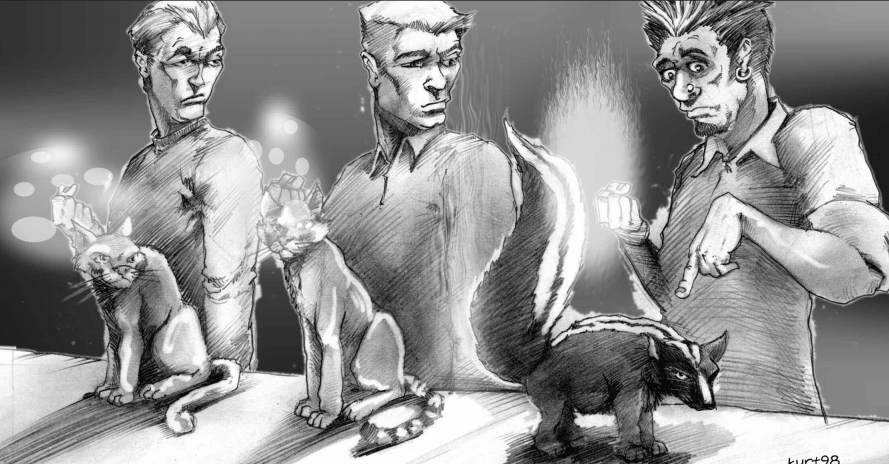
Chapter 2: Magic
Magic is kind of a big element of Technomancer. You've probably guessed that, though, given all the background information and the fact that "-mancer" is right there in the damn name. So, really, it's not all that surprising that the second chapter of the book is all about it.
Mana Levels
GURPS magic has its users utilize ambient magic energy, or mana, to fuel their spells. Mana is almost everywhere, but some places have better quality mana than others. The normal amount of mana in an environment allows mages (anyone who has the Magery advantage) to cast their spells. Lower is low mana (mages suffer a -5 to their spell rolls) and no mana (nobody can do shit with magic), while higher is high mana (anyone who knows spells, even non-mages, can cast them) and very high (not only can anyone cast spells, but mages automatically regain the energy they expend on spells the very next turn). There are no mana-void areas in Technomancer, but you will get into low mana territory if you are in any part of space other than around Earth or Mars. There are also two big high mana areas: Antarctica and the Manabelt. The Manabelt is the region stretching out in a 200 mile radius around Alamogordo, New Mexico, the place where everything began. The Manabelt is the go-to place for religious rituals, Agrarian Conspiracy communes, and weird phenomenon randomly appearing to say hello.
The Theory of Magic and Nature of Spells
GURPS Technomancer posted:
Full mathematical understanding of the Hellstorm and the nature of the “Oppenheimer Backfire” that triggered it did not come until 1984, when Hawking’s proof of the Many-Worlds Hypothesis demonstrated what most people already knew: We Are Not Alone, and You Can Get There From Here. Everyone hopes that he’ll get back safely some day.
Old Tradition , or OldTrad, is straight up religious ceremony. Christian, Muslim, Jewish, Buddhist, Hindu, Shinto...doesn't matter what your faith is, you use OldTrad if your rituals rely on invoking some manner of god, spirit, or venerated figure. Unsurprisingly, this is the oldest form of ritual due to the fact that humans have been doing it since the dawn of the species. OldTrad isn't the most simple ritual, however. That award goes to Kindermagic , a form of early age magery wherein children between 3 and 6 years of age create nonsensical phrases and rhymes that happen to get them into the right mindset to cast extremely minor spells. It's assumed that once you grow older, you will learn the "proper" rituals for the spells you manifested with kindermagic as a child, and a teen or adult still utilizing these early methods for any spells is seen as just socially awkward enough for it to be a -1 point quirk.
The rest of spellcasting can be fairly lumped together as "academic magic" , including subsets such as magic created by computer algorithms, reverse-engineered laboratory spells, and the kind of magic taught at universities. Almost all of the spells of GURPS Magic are stated to exist and have been written down in the textbooks of magic academia, save for some special exceptions. First off, resurrection spells and dimension-crossing magic are both off the record: if you're dead you're either staying dead or becoming a horrific undead monstrosity, and there's no known way to get to the Otherworld or the demon realm. There are also some spells that are classified military secrets. Invisibility and ethereality, body swapping, spells that tamper with the soul, and spells that manifest radioactivity are all under wraps. Don't have clearance? Then you don't get those spells, buddy.
Next Time, in Technomancer...
New spells and enchanted items. Learn the arts of magic bullets, supernatural static electricity, pregnancy transferal, and more.
Chapter 2 Continued: Spell Descriptions
Original SA post
Chapter 2 Continued: Spell Descriptions
David Pulver posted:
Unlike many other roleplaying settings that mix magic and technology, I postulated magic would not remain an arcane force outside of the mainstream, but would rather be embraced by it. By treating magic as a new branch of physics, I may have lost some of the mystery, but I have always felt that this is an element that some game designers place too much attention on. In many real-world occult systems, magic follows well defined (if fictional) laws – so why not make it that way in a game?
Unsurprisingly, a setting that relies a lot on magic happens to have new spells: a whopping one hundred and six of them. Like standard GURPS magic of all eras, spells are more or less skills under a different name and a Fatigue Point payment whether or not you succeed the skill check. What is different is that a lot of the spells are actually quite interesting. Sure, given the sheer volume of new spells, there are a few unimpressive ones like Identify Plastic or the like, but even otherwise unimpressive spells at least have novelty for the setting, including Speed Data (double your modem's data transfer speed) and Delete Commercials (self-explanatory).

The spells you find in GURPS Technomancer are focused heavily on the synergy between technology and magic. Indeed, as you may have guessed from the quote by the author up top, magic doesn't simply complement technology, it turbocharges it into a wild and screaming future. I'll admit I might be biased in Technomancer's favor here in that I'm far more of a fan of this method than the idea of magic and technology are diametrically opposed forces that cannot coexist safely. Rather than attempt to talk about spells by school and inevitably have some schools where nothing gets spoken about or do a "top picks" bullet point list, I've decided I'm just going to look at spells from the perspective of their intention.
Spells of Convenience: Not every piece of magery needs to be something destructive or even all that earth-shaking. Sometimes you just want to have an easy way to help with the daily grind. One of the biggest examples is Necrovision™ , a spell created and trademarked by the corporation Necrotech for the express purpose of letting those who pay to learn the spell be able to watch cancelled television shows. In the far off era of 1999, before Netflix and Hulu were even a glimmer in our eyes, this spell is both popular and controversial: many companies have begun to bring in the lawsuits against Necrotech for violation of syndication rights. Another would be Elemental Plumbing , wherein you bind a water elemental to your house's plumbing so that you can get fresh water of any temperature on command. Some other examples: you can overclock your PC with Upgrade Computer , be your own surge protector with Purify Power , and even ensure your financial future with the stock market divination spell Plutomancy .

Spells of War: Of course, while not every spell has to be destructive, some inevitably are. This is especially true when you live in a world where the Cold War helped fuel a lot of the magical revolution. Some spells on the battlefield are innovations on old fantasy staples, such as taking Fireball and adding concussive force to make it High Explosive Fireball or adding molten metal for Shaped Charge Fireball . Others are the reverse, grafting magical capabilities onto technological weaponry: take an ordinary missile and make its explosion spawn a murderous undead skull with the spell Skull Spirit , for instance, and the Magic Bullet spell turns a firearm into a deadly homing weapon. Oh, and then there's Gun to Butter ...it turns a firearm into butter or margarine. I'm not sure why it exists but I had to mention it.
Spells of Malice: Or "spells I couldn't figure out how to classify beyond that they are detrimental but not military". Sometimes, people are just plain assholes. How else would you explain the creation of spells like Game Addict , which enchants a slot machine, pinball table, arcade game, or video game so that the next person who plays it is unable to stop playing, even for basic body function needs, until they are unable to due to either extraneous circumstances or falling unconscious? Or Curse Virus , which creates a supernaturally powerful computer virus? And let's not even begin to think about the mindset of whoever created Hellspawn , a spell that impregnates someone with a demon.
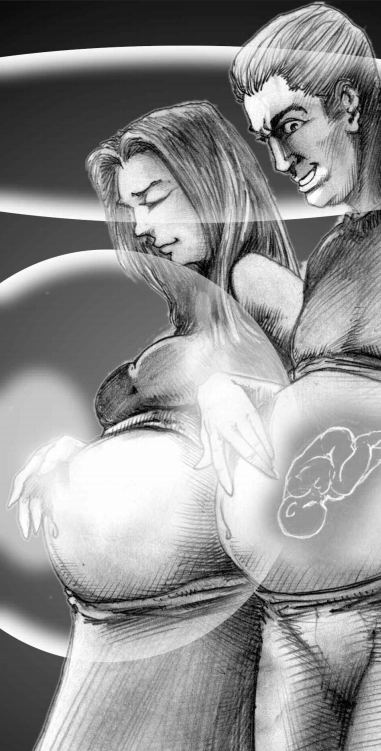
Spells of Augmented Humanity: While not explicitly a transhuman setting, it is probably worth remembering that GURPS Transhuman Space was designed by David Pulver just like Technomancer was, and some similar ideas about altering humanity through some greater power are present here as well. A lot of them end up dealing directly with fetal matters. If you want a particularly special child, you could always give them an inherent magical power with Spellgraft , or make them some confusing furry with Create Chimera . Don't want a child at all? Well, that's not a problem either. Medical mages have two options for you there: Remove Fetus lets you take the fetus out to place it in an artificial womb, while Transfer Pregnancy straight up shunts the fetus to someone else's womb (and even grows them a womb if they don't happen to have one). These spells have both aided in reproductive rights and created an alternative to abortion that pro-life groups have found acceptable. There's also some good old-fashioned mechanical augmentation present in the book if that's more your style, the most variable being the spell Partial Mechamorphosis . This specific form of shapeshifting has ten specific uses given, including transforming your arm into a chainsaw, a finger into a pen or screwdriver, feet into wheels, and ears into radio antennae.
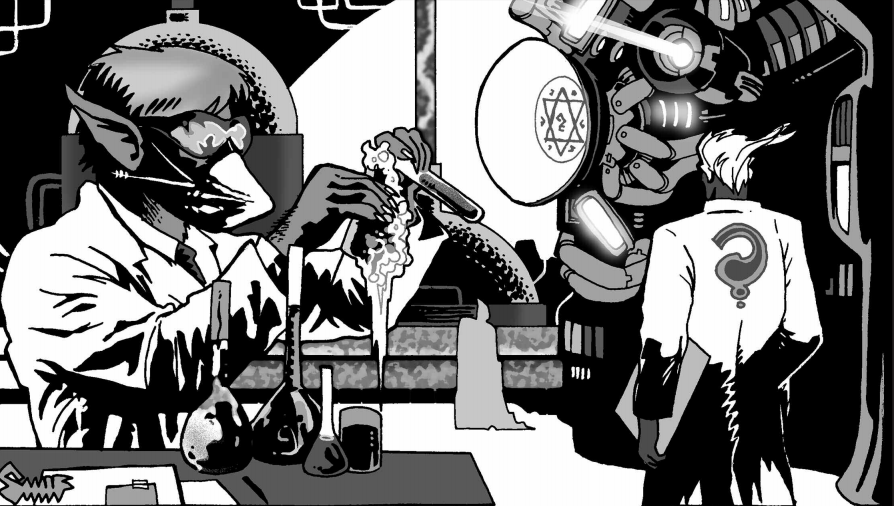
Chapter 3: High-Tech Enchantment
Industrial Enchantment
This isn't your daddy's magic items economy! Rather than go find some weird artificer out in the boonies, the world of GURPS Technomancer has a new system it refers to as industrial enchantment. Entire factories with vast assembly lines are used by dozens to even hundreds of mages that methodically weave portions of a spell together in a great rhythm. While it may be a bit exhausting on your Fatigue Points, the pay isn't too bad, with an average assembly line enchanter's salary being $375 a day. And what exactly is manufactured in such a way rather than by individual enchanters? We aren't privy to exact products, but some general ground rules are given that if a spell can be manufactured to replicate a mundane device at a cheaper price in the long run, cost-effectively improve upon a mundane technology, are labor-saving, or do something that non-magical technology simply can't, it's likely to be enchanted en masse. Cook, Flying Carpet, Hide Thoughts, and Teleport Other are given as some commonly manufactured spells.
Radiation and Necrotechnology
While industrial magic may be the frontliner for chapter 3, the brunt of it discusses the force that caused the entire world of Technomancer to exist in the first place: radiation. Nuclear radiation is innately bound with necromantic power and can even spawn demons from a dimensional breach if things go to shit. Given how hard it is to get people to accept nuclear power in the real world, you can probably surmise how well the idea of nuclear reactors that can also randomly spawn literal hellbeasts went over in the early Cold War era. It wasn't until the late '70s and early '80s that Oz particle interaction with nuclear radiation was understood well enough that the public could accept the presence of NEMA (nuclear-enhanced mana area) reactors, nuclear reactors outfitted with special precautions such as pentagrams to seal any unwanted demon activity and special ectoplasm-coated power lines to allow both electicity and mana to be pulled from the reactor.
There's also the matter of waste and leakage. While strictly monitored, there's always the potential for something to go wrong, like what happened at Chernobyl, and radiation sickness is the least of your worries. Radiation sickness can rapidly progress into one of two even more sinister conditions: you have the chance of either getting TZS, which rots you alive until you end up becoming a zombie, or vampiric leukemia, which makes you into a vampire. It's even possible to have a demon possess and then transform you into their own likeness if you get a ridiculously high amount of rads in your system. Pregnancies affected by radiation can similarly end up in the birth of a vampire fetus, a defect-addled mutant, or the best case scenario of a baby who is innately magical but can only ever be able to learn or cast necromancy spells. These are all very good reasons why so many laws and precautions are in place in the first place.
Last on the radioactive information list would be necronium, a radioactive and mana-active metal that is used to power NEMA reactors. It also happens to be a convenient superweapon, since it doesn't have that pesky "could cause the fabric of reality to unravel" problem that standard atomic bombs do, and necronium happen to be used by all the same nations that use nuclear weapons in real life. A less terrifying but nonetheless potent piece of machinery necronium is used in is the necrolaser. Developed by Necrotech in 1988, these fancy devices shoot fluorine, gas, and ectoplasm through necronium mirrors to create violet beams of necromantic energy.
Oh, and speaking of ectoplasm, it gets a full discussion in this chapter as well. What's special here isn't the actual description – it's just slimy ghost juice that the undead leak, as it often is in fiction and pseudoscience alike – but what's done with it. Specifically, tons of spiders are killed and then reanimated to make zombie spider farms because their silk is naturally ectoplasm-laced. This so-called solid ectoplasm is then either embedded into silicate composite material to create Ectite™ cables such as those used to transfer power from NEMA reactors or in machines utilized by industrial enchantment facilities, or simply woven together into necromancy-resistant Ectoweave™ body armor.
High-Tech Alchemy
Like enchantment, but in (usually) liquid form. Alchemy has basically been heartily subsumed into the pharmaceutical business, who have manufactured ways to deliver their elixirs in aerosols, cigars and cigarettes, inhalers, and hypodermic needles rather than the old-fashioned potion bottle. Like other pharmaceutical products, there's also various regulations surrounding alchemical elixirs. Elixirs such as those that create natural sunblock, grow or remove hair, or prevent tooth decay for a period of time are freely given over the counter. Other elixers are prescription-only, such as those for weight loss, age reduction, or fertility. And then there's the illegal ones: love potions and drunkenness potions are considered date rape drugs, combat-effective elixirs are restricted to military use, and invisibility and resurrection elixirs are top secret government projects that nobody in the general public knows about. Outside of that last pair, though, there are always some people out there that are illegally shipping and selling elixirs that people want to buy on the black market.
Genetic Thaumaturgy
Genetic engineering is a lot easier when you can just magic up weird effects. Even with the issue of the Human Genome Project being a decade from completion (which is strange, given that there is a spell specifically for gene sequencing), enough is known that you can do some truly wild and wacky things. Unfortunately for those aspiring mad wizards out there, a lot of said wild and wacky things are actually illegal. It is illegal in the USA and many other nations for a mage to engage in human genetic engineering except for medical therapy purposes or to create biological weapons. Like prescription and illegal elixirs, however, there are always outlaw mages with knowledge of spells such as Create Chimera and Spellgraft who are willing to get a big payday in spite of the risks.
Golems
While what I'm about to write about is not actually in the GURPS Technomancer book, it is technically official, just cut content. Golems: they're a fantasy staple at this point. Technomancer even gives them brief mentions in sidebars discussing that war golems and plastic pleasure golems are both things that exist. But why briefly mention golems when you could talk about them in depth? GURPS contributor Hans-Christian Vortich apparently had the same idea, as back in the day he wrote a chunk of information about golems of war. The leading producer of golems from the Cold War onward has been the Cadillac Golem Company, a subsidiary of General Motors. Their 1969 and 1970 GLU-1 (Golem Life Unit 1) series, nicknamed "Iron Men" due to the fact that at the time iron and clay were the only materials that could be enchanted by still relatively green industrial mages, effectively filled the same role as tanks: big, pricy hunks of metal that make up for their slow speed and need for human direction by being murderous armored powerhouses.
These 7 to 10 foot tall blocky-framed metal men were given specific designations based on their armament, with GLU-1A golems wielding dual machine guns, GLU-1Bs similarly dual-wielding grenade launchers, and GLU-1Ds wielding a huge recoilless rifle. We don't know what happened to GLU-2, but in 1979 the GLU-3 "Silver Man" was rolled out, now being created out of titanium rather than iron. A special dual riot shield-wielding variant called the Shield Man was also created to be used as a hostage rescue unit by the FBI. Outside of the United States, the two most famous golems are Mexico's Titanio Almado Modelo "Balam", which is more or less a Silver Man with a jaguar head shape for flair, and the human-sized (and thus somewhat cheaper in build costs) Soviet Uralgonzavod.
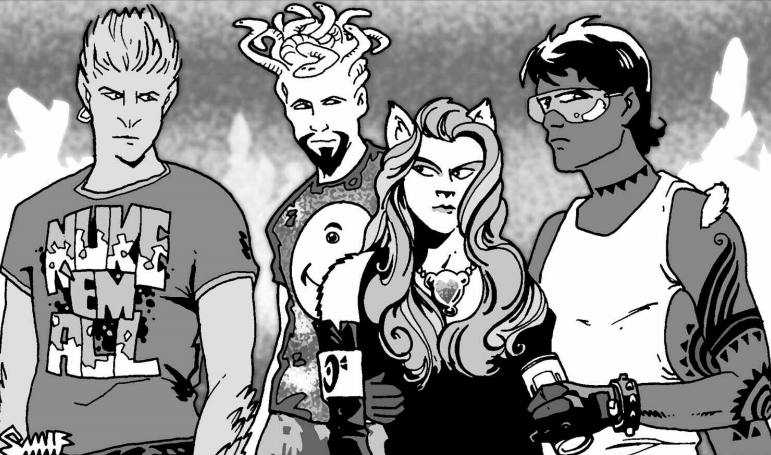
Nonhuman Races
Human Chimeras
Half animal, half human, all American. Or at least it's assumed so, because all six known species of human chimeras are formed from animals found in the American Southwest and none have been reported outside of the region of original Trinity fallout. This seems to definitely shoot down the idea that chimeras are actually the results of either Seelie genetic engineering or the results of recessive genes from a time in the distant past when mana was present before disappearing until the Trinity Event, both of which are postulated hypotheses in a sidebar. There are at least a few things that are definitely known. All human chimeras can speak with animals related to their beastly half, take extra damage from silver and necronium, suffer from emotional outbursts and laziness during the full moon, and require a daily exposure to ambient mana to stay healthy.
...Oh, and chimeras can't breed with each other, but can breed with humans, as all of them have human genitalia. This is detailed to us for reasons that are unclear, and I'd honestly probably rather have them stay unclear. With that
 bit of information on human chimeras out of the way, let's meet our misfits.
bit of information on human chimeras out of the way, let's meet our misfits.
-
Spider People (81 Point Template):
The rarest and most mechanically expensive chimeras, the spider people are sort of like centaurs, only instead of a majestic horse you have a huge-ass tarantula as the junk in your trunk. If you're a spider person, you get the benefits of having a good amount of lower body strength, wall-climbing, web-spitting, and having venom-laden fangs in your otherwise human mouth.
-
Coyote People (5 Point Template):
An anthropomorphic coyote. They can hear and smell better than humans, but are otherwise not all that powerful and are also probably not seen as being as cool as werewolves would be.
-
Cat People (19 Point Template):
Anthropomorphic cats, which oddly enough are specifically stated to have human hair on top of their furry cat heads while coyote people get no such statement. On top of being good at the things coyote people are good at, cat people also have night vision, impeccable balance, quiet movements, quick reflexes, and reduced damage from falls.
-
Hawk People (-18 Point Template):
Like spider people, the hawk people are inexplicably not anthropomorphic/furry/whatever types. Instead, they follow the harpy design, with human torso and head but hawk everything else. Hawk people have powerful claws, can fly, and have great vision, but also have brittle bones.
-
Snake People (25 Point Template):
Snake people have a long serpent body and tail instead of legs, a forked tongue, fangs, and slitted pupils, and are even referred to as nagas to bring home the fact that they are like the spider people and hawk people rather than the anthropomorphic triad. On top of being extremely flexible, having infravision, and having both the squeeze of a constrictor and the venom of a viper, snake people actually have innate supernatural powers: specifically, they get Magery 1 that is limited to Communication and Empathy spells and three free ranks in the Persuasion spell.
- Fox People (-9 Point Template): And we're back to the furry shape species. They are mostly mechanically similar to coyote people, save that they have reduced total hit points and can innately cast an illusion to appear human.
Chimera Halflings
Weird things happen when chimeras and humans have sex. There's a 25% chance the baby is a chimera, a 25% chance it's a human, and a 50% chance it's one of these. Halflings are there for if your flavor of animal people is more anime than furry. Or if you want to pay less character points, since they have lesser versions of their parents' sensory abilities in exchange for taking less bonus damage from silver, no bonus damage from necronium, and not having a mana dependency. Cat, coyote, and fox halflings all have the ears and tail of their species but otherwise look human, hawk halflings have feathers instead of head and pubic hair, snake halflings have slitted pupils, forked tongues, and snakes for hair, and spider halflings get venomous fangs and six arms for their "we're not completely human" look. You can see a hawk halfling, snake halfling, full-fledged cat person, and spider halfling in the image I used to introduce this chapter. Moving on.
Atomic Lich (230 Point Template)
A CIA black ops project in 1973 was undertaken to attempt to artificially make mages by making them chug radiation-laced potions. Surprisingly, this didn't actually work as planned, and all two hundred and three test subjects died. What a shock! In a non-ironic surprise, thirty of them came back, now with a new unlife as pissed off glowing skeletons that the CIA dubbed atomic liches. The liches escaped from the facility and fled to the winds, and while seventeen of thirty have bene murdered, the rest have managed to either stay hidden or gain a significant power base to stay alive. One of the most powerful is the mafioso and "Dark Lord of Chicago" Elrond Carver, who rules the criminal underground of the American Midwest. Even the atomic liches that aren't crime bosses are still extremely dangerous: on top of all the perks of being an unliving monstrosity, they have increased strength and hit points, innate Magery 3, leak radiation for about two or three yards around them, and can breathe a cone of radiation Godzilla-style.
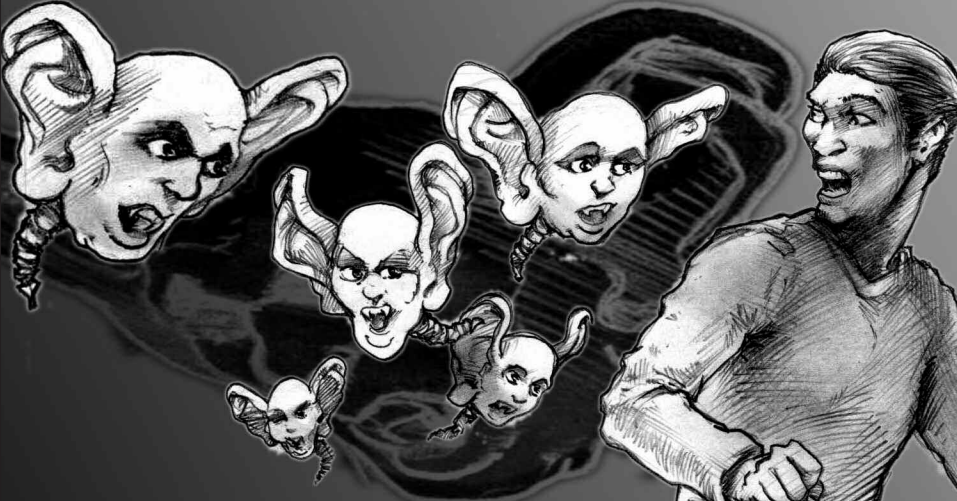
Chonchon (92 Point Template)
Believe it or not, these undead heads that fly using their massively enlarged ears are actually based on a creature from mythology. Most chonchons are delirious and driven by nothing more than basic blood hunger, some eventually come to their senses and attempt to relearn how they were before they became weird flying head vampires. Chonchons can become invisible to both living and machine vision and have vicious bites that can spread an infection that causes the afflicted to become a chonchone themself if they succumb.
Zombies
Technomancer's zombies come in two flavors: necromantic and toxic. Necromantic zombies are your straight up D&D-style mindless undead corpses, not anything particularly special, and the entry even just points you to GURPS Magic for its zombie stats rather than give any new ones. The only state in the union where it's legal to create necromantic zombies is Louisiana, where they can be animated for "death plus hard labor" criminal sentences since even in fictional universes we've got a horrible prison system. Criminals are stated to use zombies as servants, enforcers, laborers, and sex slaves (treated with a Sterilize spell and plastic coating, because apparently necrophiles are at least cleanly about it in the Technomancer-verse).
Toxic zombies, on the other hand, are very conscious and very dangerous. These are the types that you become if you suffer from TZS, and it's not a pleasant experience. You slowly lose points of your IQ stat day by day, and the only way to recover it is to consume the brains of sapient beings: one point regained per brain. It's sort of a lose-lose situation, as you either eat brains to retain your knowledge and sense of self or you devolve into a slavering flesh-hungry beast and thus end up eating brains anyway. Luckily, they're also only a bit stronger and tougher than humans, with most of their power being from the benefits of no longer having to eat, sleep, breathe, or any of those other pesky human body function limitations.
Vampire (270 Point Template)
Everyone's favorite undead bloodsuckers. Technomancer's vampires are extremely strong and durable, making them more than capable of overpowering even spider people in order to drain the blood of sapients, which they need to survive. On top of physical power, they are also invisible to machines, can transform into an animate shadow, and innately know 5 ranks of the spells Create Servant (reflavored as animating a person's reflection rather than just creating a servant automaton), Shape Darkness, and Teleport. Of course, every vampire has its weaknesses as well, and the ones here suffer from being unable to heal themselves even with blood draining, a constant mana dependency, the need to rest in soil from their homeland daily, a weakness to sunlight, and vulnerability to silver and necronium.
Spirits
Spirits come in several forms: animating spirit, ghost, shade, and holo-ghost. The first is probably the best understood, as they are frequently channeled to bring life to inanimate objects and necromantic zombies. An animating spirit is not anyone's soul or animus: instead, it's merely a psychic after-image, a shard of universal memory of a person who is now deceased. They don't have any memory, free will, or a stat block as they are merely a means to a spell-related end.
Not a lot is actually known about proper ghosts. They're dead, they're ectoplasmic, they are actually someone's soul, and they come from some where that indicates there's some manner of afterlife or at the very least a halfway point between life and true death, but that's about all anyone can surmise. Another similar type of undead is the shade, which is the ghost of yourself from a possible future. Both of these have a reference to go look at the book GURPS Undead for more on them, but there is at least one fully statted Technomancer spirit in the holo-ghost. These guys are basically what happens if you intentionally try to create an animated spirit that has a presence outside of an object and retains the memories of the person it was made from.
How is that done? Well, you need to have a necrolaser, a roll of camera film made from necronium shavings that is used to photograph a still fresh corpse, and the ability to cast the spell Summon Spirit. Put them all together and you have your holo-ghost. While holo-ghosts are intended to effectively be interactive holograms of the recently deceased, they have free will and can potentially break out of whatever binds them before they get dispelled, and are even allowed as a player character racial template. The perks you get for being a holo-ghost are the benefits of incorporeality and undeath, innate Magery, and the ability to go invisible or possess people, but you also have the drawbacks of having one gnawing obsession or compulsive behavior and a constant mana dependency.
Dragons
Blue, red, and black dragons are the three types of dragon in the world of Technomancer, and only one of them actually has the same coloration as their name. Blue and red dragons (401 point racial template) are 20 feet of deadly winged reptile that actually have green scales and gold eyes. They are given their two names based on whose side they're on: they're blue dragons if they are the ones that are servants of the USA, UK, and Israel, and red dragons if they're the ones from the Soviet Bloc, Egypt, and Syria. There are also extremely rare cases of "wild dragons", specimens that came through the Trinity rift but managed to slip under the radar rather than be killed and have their egg clutches taken to be raised by humans. At least some are known to live in the barren far north of Canada and the Peruvian Andes.
Not only are dragons extremely strong and durable due to their sheer size and thick armored hide, they are also actually pretty smart. They're only IQ -1, which is the same intelligence score given to Neanderthals in GURPS Dinosaurs and GURPS Ice Age, which means they can actually think and plan out their combat strategies. These flying furnaces are capable of breathing fire and innately learning fire magic on top of the trifecta of claws, jaws, and a powerful alligator-like tail. Their only real flaws are that they have constant mana dependency (which usually isn't a problem in GURPS Technomancer, but you never know), require three times as much food as a human soldier would which can potentially cause logistics issues, and they can regress into a bestial state if put under extreme psychological stress.
The other type of dragon is the black dragon. These are literally the setting's stealth bombers, even having been hatched in the Lockheed Skunkworks from genetically modified blue dragon eggs. While they are the same length as blue and red dragons, black dragons are thin and agile rather than thickly muscled powerhouses. They are invisible to machinery and don't cast a shadow, but also take damage from sunlight, leading to rumors that the secret recipe for making black dragons involved vampires or some other form of undead. This claim isn't exactly hurt by the fact that they also innately learn necromancy rather than fire spells and have radiation breath rather than fire breath.
Elementals
If you remember your Paracelsus, the classical four elementals are gnome of earth, undine of water, sylph of air, and salamander of fire. Technomancer uses the Paracelsan elementals rather than D&D style blobs of matter, and furthermore modernizes them by stating that they are more accurately described as personifications of the solid, liquid, gas, and plasma states of matter rather than nebulous Medieval concepts of essential planetary materials. We also learn that they are free-willed and have anywhere from chimpanzee to human levels of intelligence depending on the individual elemental, which makes the Elemental Plumbing spell from chapter 2 horrifying in hindsight. It's even noted that there are activist groups attempting to change elementals' legal status from natural resource to free citizen.
Elementals are capable of experiencing all the emotions we can. Some feel comraderie and companionship with humans that actually treat them nicely, and some even engage in sexual acts with mages who cast Body of [Element] spells specifically for that purpose...never underestimate humanity's ability to learn how to fuck things, I guess. There are also elementals that aspire to be learned magi (as each elemental innately has Magery 3 with a limitation to spells of their specific element), elementals that rally with environmental activists, and elementals that work with ecoterrorists. Mechanically, all elementals share a lack of need to eat, drink, or sleep, an unaging body, constant mana dependency, and a social stigma of being valuable property.
And with the generals out of the way, let's get to the specifics.
-
Air Elemental/Sylph (57 Point Template):
As mercurial as the winds they are made from, sylphs are impulsive, capricious, and easily distracted. The only thing that all sylphs have a solid stance on is that air pollution of both natural and anthropogenic natures are intolerable. Yes, natural too, as in some of them are known to get mad about volcanoes. Sylphs are incorporeal and swift fliers, and are also capable of attacking in combat by creating super-fast jets of air that can actually cut things in the vein of Avatar: the Last Airbender or various manga and anime.
-
Earth Elemental/Gnome (80 Point Template):
Gnomes look like grumpy-faced rock men. They also act like grumpy men for that matter, being callous, stubborn, and reclusive. Gnomes can burrow through the ground and are particularly sturdy thanks to being made of stone, but otherwise aren't all that interesting mechanically.
-
Fire Elemental/Salamander (110 Point Template):
These guys look like humanoid blobs of heated plasma rather than salamanders, and also hold the esteemed position of probably being the biggest assholes out of any of the elementals. Salamanders are both egocentric and impulsively pyromanic, setting things on fire because they feel that the blaze is beautiful art. They are made of fire, immune to fire, and shoot jets of fire. Fire.
- Water Elemental/Undine (48 Point Template): A humanoid figure made of water. They swim, rapidly regenerate damage when in large bodies of water, can shoot high-pressure water jets, and are not given any really interesting flavor text at all. Oh well, they can't all be mind-blowing.
Angels
GURPS Technomancer posted:
The majority of Christians and Moslems believe that angels exist and are real beings, but this remains unproven. Many people claim to have seen them, but mainly in visions or dreamlike experiences. Mainstream theologians believe that angels do not appear directly, as faith is more important to God than providing direct proof of His existence through messengers.

Demons
Demons come in a variety of shapes and sizes, but all share the bond of being consummate liars. They claim to be whatever is conveniently scary and threatening to their audience at the time: Goetic demons, eldritch horrors, hellish characters from popular fiction, and even Old Scratch himself. They aren't actually any of those things, mind you, but it doesn't hurt to play pretend when you have the goal of messing with people. Scientists are split between two theories about demon origins, feeling that they are either extradimensional beings that psychically latch onto the subconscious of someone around the area they are summoned at or are in fact just figments of a mage's imagination taken shape when a summoning spell is cast or a horrible magical mistake accidentally summons one. The latter is a bit less likely given that demons can also spontaneously appear at nuclear events, but is handwaved away by proponents as being dark energy attached to nuclear radiation being affected by the nearest people at random times.
Whatever demons actually are, they all share the same base 34 point template, which seems to be a conceptual precursor to what would become meta-traits in GURPS Fourth Edition. Their shared boons are a lack of need to sleep, immunity to disease and to spells that have an IQ saving roll, night vision, and agelessness, while on the minus side they are all emotionally callous, vulnerable to silver and necronium, cannot harm "truly good folk" (whatever that specifically means), recoil from the sight of holy symbols of any faith, and have constant mana dependency. They're also considered outlaws by society and are officially excommunicated from the Catholic Church, but I doubt they actually care about either of those disadvantages. Four specific demon forms are given example stat blocks.
-
Gremlin (224 Point Template):
Gremlins are technology-targeting demons that look like people with the ears and tail of a rat. Not only are they invisible to machines and capable of innately casting technology spells (all of them already know the spells Glitch, Machine Control, and Reveal Function specifically), they can shrink down to a miniscule size in order to wreak havoc in the innards of machinery. The CIA claims that Iraq and Argentina have weaponized gremlins, while other nations say the USA has them, but nobody really knows.
-
Hellraker (169 Point Template):
Compulsive murderers and sadistic torturers, hellrakers resemble the stereotypical horns, hooves, and red leather skin kind of demon. They're a horrific mess of claws, horns, fangs, damage regeneration, and brute strength and endurance who love nothing more than a good blood bath.
-
Malebrachne (177 Point Template):
While they look like satyrs (though some are female rather than male), malebrachne are anything but revelrous. Their delight comes through making others fall onto a dark path, and they have an arsenal of tools to do so: innate charisma, fast-talking skills, shapeshifting to disguise themselves, and invisibility to try to trick people into believing they are suffering from voices in their head.
- Succubus/Incubus (215 Point Template): Your stereotypical bat wings, spade-tipped tail, and horns on an attractive woman or man type of succubus or incubus. They're carnal symbols of lust and lechery, and the ones that aren't bound to some mage are typically prostitutes, strippers, or horrific rapists by choice. These demons are technically infertile, but can store sperm in succubus form and then release it in incubus form. Succubi/incubi have slightly higher Strength and Dexterity than humans, the ability to change sex at will, shapeshifting as an innate spell, pheromone powers, double-jointed limbs, sharp teeth, claws, and a +3 bonus to the Erotic Art and Sex Appeal skills.
Chupacabra (42 Point Template)
Nobody's quite sure what the hell these guys are. They definitely look demonic, with their reptilian legs, glowing eyes, taloned hands, leathery gray skin, and spiked back, and they were even briefly thought to be demons back when they first appeared in the '70s, but they don't react to summoning, holy symbols, or other things that would mark them as being demons. Seelie believers claim that they are some hybrid between faerie and vampire whipped up in a secret government lab, and also claim that they are behind cattle mutilations seen in areas soon after Seelie visitations. Others say it's some sort of weird animal that evolved from the Trinity event. The truth? Unknown, but it probably doesn't matter to you when one is looking you right in the face. Not only are their mess of jagged teeth and talons an obvious danger, they are also capable of extreme speed and long frog-like leaps and can spray venom like a spitting cobra. Chupacabras are technically shy, but they have been becoming more and more bold recently, even attacking and draining blood from humans rather than small wild animals and livestock.

Killer Penguin (113 Point Template)
Hello, best creature in Technomancer.

The killer penguins are the end result of the Soviet faffing about in Antarctica, in more ways than one. Not only did they gain rudimentary grasping hands and sapience from the Russian atomic testing, Russian vivisections of them lead to a species-wide burning hatred of humanity since they turned out to have a hive mind and millions of people feeling the same horrifying pain at the same time doesn't do great things for interspecies tolerance. After murdering the weakest Russian outposts first, the penguins learned how to use guns and cast Soviet military spells, rallied their troops, and eventually ousted humans from Antarctica and declared their own independent communist state. They now manufacture magic items in grand ice cities and sustain themselves through planned fishing villages that equally distribute food throughout the continent. While technically all mindlinked, killer penguins are nonetheless independent (albeit loyal to their people), and several species have their own political power blocs. The king and emperor penguins are one clan, as are the adelie and chinstrap penguins, with macaroni, rockhopper, and gentoo penguins being neutral parties between the two. There doesn't seem to be any active danger to the rest of the world at this point, but a group of radicals calling themselves the Human Liberation Front have recently taken over a small island off the coast of Antarctica and plan on eventually annexing parts of the mainland, which has some worried that it might be the straw that breaks the camel's back when it comes to uneasy peace between the penguins and the rest of the world.
All killer penguins are amphibious, resistant to the cold, immune to attempts at fear and coercion, have a mental link with all other killer penguins within a 1,000 mile radius, innate Magery 1, poor grip with their stubby little flipper fingers, constant mana dependency, and loyalty to the collective. On top of that, chinstrap penguins are quick on their feet but also violent and bloodthirsty, emperor and king penguins are hardier than other species, gentoo penguins are weak but particularly good at swimming and have a daily rather than constant mana dependency, and macaroni penguins have innate Magery 3 rather than Magery 1 but are also less effective at resisting the spells of others.
Seelie
The Seelie, also known as faeries, are a big mystery. While a CNN poll suggests that 52% of the American population believes in them, there is no hard evidence beyond the claims of eyewitnesses and abductees and smooth iridium metal projectiles referred to as elfshot that are supposedly used by the Seelie. Some claim that mysterious Mages in Black come to take away evidence such as elfshot and to silence people who "know too much." Others say that they've seen forced impregnations and forced fetal removals during their abduction experiences. Is any of it real? It's unknown.
If you couldn't guess by now, Seelie are extraterrestrials with a magical veneer painted on the top. UFOs become "elf hills", abduction is carried out by the Loyalty and Walk Through Earth spells rather than technological paralysis, spells are used in place of medical technology, etc. David Pulver originally planned on having the Seelie have full stat blocks and be a solid thing, but GURPS line editor Sean "Dr. Kromm" Punch convinced him that having them be statless mysteries would work out better in the end, and thus here we are.
Next Time in GURPS Technomancer: Character mechanics and the role of magic in society.
Chapter 5: Characters and Campaigns
Original SA post
Chapter 5: Characters and Campaigns
GURPS Technomancer posted:
“Cactus farm? Yeah, I guess they are pretty when they bloom, and . . . oh, I see. I didn’t know the pollen . . . Cross-hybrid managenic experiment, huh? Yeah, I understand you don’t want the authorities involved . . . no problem.” Daphne put the phone down. “Eric, you ever dealt with a mutant toxic zombie walking cactus with strange powers over killer bee swarms?”
“Nope,” Eric said. He strode over to the weapon rack, hefted the flamethrower. “Always a first time.”


Character Templates
Assuming you aren't familiar with GURPS, character templates are effectively the closest thing the system has to character classes. It narrows down point buy from "you have almost free reign, save for what the setting and Game Master disallow" to having a specific set of options based on a unified character concept, allowing you to spend less overall time creating a character if you are really unsure of what you want to do. GURPS Technomancer also manages to be one of the few cases where there's actually a reason I shouldn't skip over discussing character templates that are related to real world occupations. Specifically, it's because Technomancer is kind enough to actually give you a list of spells that mana-capable members of otherwise mundane occupations are likely to have. I won't try to go over all the advantages and disadvantages you can potentially take and instead give a general gist, as well as a look at some of the spells you expect to see. If there are two point costs listed, this is because the lower of the two is for not having magic and the latter is for having it.
Alchemist (80 Point Template): The people who produce potions and other elixirs. Most alchemists work for big pharmaceutical companies or local community drug stores, but there is also the scourge of black market alchemists that the Drug and Alchemy Enforcement Agency work hard to try to keep tabs on. Unsurprisingly, the template focuses mainly on various alchemical and pharmaceutical bits and bobs, a high IQ attribute, and being able to safely handle hazardous materials...or at the very least avoid hurting as much if you do screw up, given that Magic Resistance and Poison Resistance are two advantages you can take as some of your options.
Artist (75/85 Point Template): This character template has a lot of varied options, as it's meant to encompass anything from painters to sculptors to dancers. It also happens to encompass entirely new subcultures of art that arose from the magical revolution, which we're obviously going to discuss.
-
Phantasists
use spells such as Perfect Illusion, Control Illusion, and Sound to create extreme special effects. While some of them are performance artists, the big bucks come in working for the movies.
-
Body styling
began as a counterculture movement, but eventually entered the mainstream like so many other forms of underground art. It revolves around using the Alter Body and Alter Visage spells to customize the human form. You could think of it as an easier to perform but even more extreme version of the body mod crowd, really.
-
Shapedancing
is a special form of choreographed artistry where the dancer changes into various animal forms as they move, playing with just how strange you can get the steps to be when your entire way of moving can randomly alter.
-
On top of traditional sculptors being able to work even more efficiently with spells that allow you to mold metal and stone as easy as clay, a special form known as
weather sculpting
has arisen entirely out of the use of magic. A weather sculptor utilizes spells that manipulate weather and light to create wondrous displays.
- Finally, deep in the underground you have the necrogoth movement. Necrogoths animate zombies or summon demons to pose for photographs and paintings, model fashion, and even "act" in satirical plays known as thanatic theater, in spite of how very illegal their art is. At least one unknown necrogoth tooks things even further and created "Gigeresque" animate sculptures by attaching various scrap metal to skeletal undead animals.
Astronaut/Astromancer (120/200 Point Template): Space wizards! Astromancers are NASA's best of the best, the people who have the magical wherewithal to go to space and survive. Powerful Teleport and Teleport Other spells allow for transit to and from either space stations or moon bases, Create Air and Purify Air keep space suit oxygen supplies at their best, and Force Dome protects from debris, to name but a few of the variety of spells astromancers are capable of mastering. Oh, and there are also traditional astronauts, but they are ultimately the less valued crew members since they can't just magic up air whenever someone needs it or zoom people into space in a split second.
Criminal (80/90 Point Template): This template is meant to reflect a variety of criminals, so it's hard to really describe it. Instead, we'll just note that there are several spell packages for specific types of criminals. Burglars get Aura, Detect Magic, See Secrets, Seeker, Locksmith, Seek Machine, Seek Power, and either Levitation or Wallwalker, fences and drug dealers get Borrow Number, Hide Thoughts, Seek Number, Sense Emotion, Truthsayer, Scryguard, Scrywall, and either Magelock or Sense Danger, prostitutes and con artists get Itch, Pain, Spasm, Persuasion, Sense Emotion, Truthsayer, Simple Illusion, and either Illusion Disguise or Illusion Shell, pimps and kidnappers get Sense Emotion, Bravery, Daze, Fear, Foolishness, Forgetfulness, Loyalty, and Panic, and enforcers get Immediate Action, Hail of Lead, Haste, Poltergeist, Steady Hand, Missile Shield, and two of Haste, Magic Bullet, Wallwaker, or Winged Knife.
Emergency/Rescue Team Member (65/110 Point Template): Firefighters, rescue workers of other sorts, hazardous material disposal teams, paramedics, and demon/spirit containment specialists. Unsurprisingly, emergency services members that have magical talents dabble in a wide variety of spells, including Create Air, Earth to Air, Extinguish Fire, Lend Health, Levitation, and Breathe Water.
Entertainer (80/95 Point Template): While this template is mechanically designed to cover live performers from talk show hosts and news anchors to singers and actors, most of the discussion of its fluff surrounds musicians. In the world of GURPS Technomancer, it was magic-using bands that received the brunt of the Satanic Panic rather than rock and roll specifically. Of course, it also was more justified, given that some bands actually were cavorting with demons and using mind control magic. And then there's this:
Entertainer Description posted:
Today, the mainstream is tamer: mystic sound-and-light shows are commonplace in pop, folk and rap, but staged mind control and ceremonial rituals require PRA permits, some off-duty SWAT cops to baby-sit and waiver forms on the tickets. Still, there are underground clubs where no one gives a damn if the audience gets mind-raped, and where the act may include zombies, vampires or demons.
Entertainer Description posted:
Since the 1960s, many of the most hyped (if not the most enduring) rock stars and stage actors have been wizards. In Japan, a teenager with a cute voice and magical powers can have a meteoric career as the latest “magical idol.”
Some of the spells marked for entertainer consumption include Ignite Fire, Simple Illusion, Voices, Volume Control, and Levitation.
Hacker/Cyberwiz (70/122 Point Template): In case you forgot this was the 90s, here's the prerequisite hackery. On top of mundane hacking methods, you also have the cyberwiz breaking into your security. Cyberwizzes are mages that use their talents to become specialized hackers. Would it surprise you to know that Bad Sight, Delusion ("The net is real life"), Overweight, and Unattractive are some of the disadvantages that a hacker or cyberwiz character can take? No, it didn't surprise me either. Perhaps more surprising is that the joke somehow goes even further, in that some of the spells that a cyberwiz is likely to learn include No Smell, Purify Air, and Seek Food. There are also some spells actually useful to hacking, of course, such as Speed Data, Machine Possession, Seek Machine, and Static Charge.
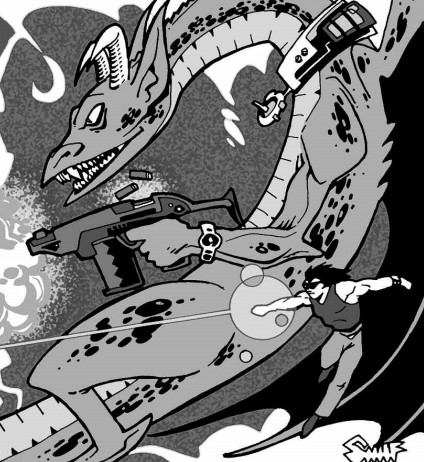
Hellhound (95/125 Point Template): In spite of the name, this isn't a template for being a magical fire dog. Hellhound is the nickname for monster hunters who are part of the Cerberus unit of GHOST, an organization we'll learn more about when we get to the organization chapter in the next post. The name has since extended to almost any monster hunter regardless of who they work for, if they even work for anyone at all. Hellhounds are stated to often supplement their business of busting ghosts and nailing down demons with more mundane work as bounty hunters or repo officers. Both magical and non-magical hellhounds are swift, smart, and not too shabby on their knowledge of melee and ranged weapons alike, but they also tend to suffer from disadvantages such as Bully, No Sense of Humor, and Stubbornness. Hellhound mages tend to aid themselves and their allies with spells such as Lend Strength, Haste, Hide Thoughts, Sense Foes, and Locksmith.
Industrial Enchanter (145 Point Template): Congratulations, you're one of the people who make magic items. On top of being smart and nerdy, the industrial enchanter gets a load of spells to use. On top of all having thirty-nine spells of a variety of sorts that include Enchant (obviously), Counterspell, Locksmith, Electric Power, Conduct Power, and Create Fire, there are sixteen more spells that are selected depending on whether the industrial enchanter works in manufacturing things for the aerospace, armament, cybernetics, necrotechnology, or personal security industry.
Investigator (50/85 Point Template): A snoopy individual, be it a private investigator, journalist, government investigator, or even a tabloid paparazzo or Seelieologist. Investigators are typically clever and resourceful but also pushy and arrogant. A mage investigator's repertoire of spells can include Hide Thoughts, Sense Emotion, Truthsayer, Far-Hearing, and Mind-Reading, though gaining information through that last one is considered unethical at best and an illegal invasion of privacy at worst.
Law Enforcer (75/100 Point Template): Cops and cop-likes, be they small time sheriffs and beat cops or federal agents. Like investigators, they are swift and clever. Unlike investigators, they have skills for making people either quite hurt or quite dead. Law enforcement mages, including those of police office's SWAT (Specialized Weapons and Thaumaturgy
 ) teams, are well-versed in a variety of protective and detective spells such as Sense Emotion, Detect Magic, Dispel Magic, Missile Shield, and Seek Machine. Similarly, like criminals and industrial enchanters, they gain an extra ten spells based on their specialization. Animal control officers get spells related to controlling animals such as Beast Possession and Bird/Reptile/Mammal Control, law enforcement detective gain even more sensory spells like Truthsayer, Trace, and Infravision, hostage assault members get confusion and combat spells including Blur, Flash, and Hail of Lead, hostage negotiators get empathic spells such as Control Person and Mind Reading, snipers have vision and shooting spells including Hawk Vision and Magic Bullet, internal affairs or secret police get sensory deprivation and empathic spells including Mind Reading, Fear, and Forgetfulness, patrol officers get a collection of hindering spells such as Rooted Feet, Daze, and Foolishness, surveillance team members get spells like Mind Reading, Far Hearing, and Stealth, and undercover operatives have spells including Hide Thoughts, Mind Reading, and Illusion Disguise.
) teams, are well-versed in a variety of protective and detective spells such as Sense Emotion, Detect Magic, Dispel Magic, Missile Shield, and Seek Machine. Similarly, like criminals and industrial enchanters, they gain an extra ten spells based on their specialization. Animal control officers get spells related to controlling animals such as Beast Possession and Bird/Reptile/Mammal Control, law enforcement detective gain even more sensory spells like Truthsayer, Trace, and Infravision, hostage assault members get confusion and combat spells including Blur, Flash, and Hail of Lead, hostage negotiators get empathic spells such as Control Person and Mind Reading, snipers have vision and shooting spells including Hawk Vision and Magic Bullet, internal affairs or secret police get sensory deprivation and empathic spells including Mind Reading, Fear, and Forgetfulness, patrol officers get a collection of hindering spells such as Rooted Feet, Daze, and Foolishness, surveillance team members get spells like Mind Reading, Far Hearing, and Stealth, and undercover operatives have spells including Hide Thoughts, Mind Reading, and Illusion Disguise.
Mageworker (85 Point Template): A mageworker is any blue collar worker who happens to use their mana instead of their muscles. This happens to be reflected by the fact that they have a boost to IQ rather than Strength, though they still have all of the skills to do things the old fashioned way if they had to. Mageworkers can pick from a variety of spells to fit the variety of jobs the template might be representing, ranging from agricultural aids such as Beast Soother, Heal Plant, and Plant Growth to construction aids including Measurement, Repair, and Reveal Function.
Medical Professional (60/115 Point Template): A mundane doctor is hard to find. It's harder to justify traditional medical school when you have people who can cast Resist Pain, Sterilize, Neutralize Poison, Cure Disease, or Major Healing to deal with problems both small and large. As a result, non-mage medics in America have been pushed back to being only used for specialty cases where the patient has either a case that is extremely specialized rather than suited for generalists, a religious objection to magic, an MRD (more on those later) or an assload of Magic Resistance. They are still common in regions where the mage birth rate is far lower, of course, and even some American medical thaumaturgical schools teach practical surgery and medical diagnosis as an elective class.
Religious Leader (75/135 Point Template): Great power comes to those who believe. All religious leaders have True Faith, meaning that they can rebuke malicious supernatural forces with their symbols of faith, and the ones who are mages get even more toys to use. They get thirty-five spells selected from a ridiculously varied list of potential spells, which makes sense given that religions are ridiculously varied. Some of the common spels include Persuasion, Sense Emotion, Enchant, Length Health, Detect Magic, Bless, Curse, and Bravery.
Seer (85 Points): Seers are professional diviners who utilize their talents for groups such as Wall Street investors or the NSA. A seer is typically clever and blessed with either wealth, luck, allies, or a mixture of the three. Seers get spells based on what form of divination they specialize in, not all of which are necessarily benevolent. Astrologers gain spells such as Air Jet, Lightning, Predict Weather, and Astrology, crystal gazers attain spells including Crystal Gazing, Earth to Stone, and Shape Earth, dream interpreters have spells including Oneiromancy, Purify Air, and Purify Water, mediums get spells such as Summon Spirit and Death Vision, numerologists only get the Arithmancy and Measurement spells but also get the advantage Mathematical Ability, palm readers get spells including Chiromancy, Shape Air, Shape Earth, and Shape Fire, and tarot readers have spells such as Cartomancy, Ignite Fire, and Death Vision.
Soldier (85/100 Point Template): Fighters and mercenaries of various sorts, from cavalry and infantry to combat engineers and supply line operators. A soldier template mage only gets the spells Sense Emotion, Sense Foes, Lend Health, Lend Strength, Illusion Shell, Know Illusion, Simple Illusion, Scryguard, Bravery, and Fear. If this sounds like not much for a fighting mage, it's because there is actually a specific template coming up that is meant to be used for a true magic warrior – a soldier mage is just considered a grunt with a few fancy toys to help out everyday duties.
Special Forces (125/175 Point Template): Seals, Spetznaz, and other groups of that sort. Swift, strong, smart, and generally talented, even a non-magical special forces agent is more than capable of doing their job. Of course, there are also magic special ops groups, one of the most infamous being hte Black Berets of the USA. The Black Berets were around since the advent of magical warfare back in 'nam, but became most famous for single-handedly fending off waves of enemy soldiers to rescue Americans during the Iran hostage crisis, crushing Noriega's spirit in the invasion of Panama, and engaging in magical psychological warfare during Desert Storm. Special forces get just as big a laundry list of spells to choose from as religious leaders, with certain staples such as Hide Thoughts, Continual Light, Counterspell, and Missile Shield being augmented by various widely disparate optional choices such as Magic Bullet, Invisibility, Mass Daze, Destroy Water, Create Fire, and Perfect Illusion.
Spook (80/140 Point Template): Spies are dangerous, especially when they potentially have magical aptitude. Non-magical spies have to deal with magical interference, but strangely enough they don't actually get Magic Resistance as an option. Spies who are mages get a terrifying arsenal of spell options to choose from, including Paralyze Limb, Wither Limb, Skull Spirit, Soul Jar, False Memory, Permanent Forgetfulness, and Flight.
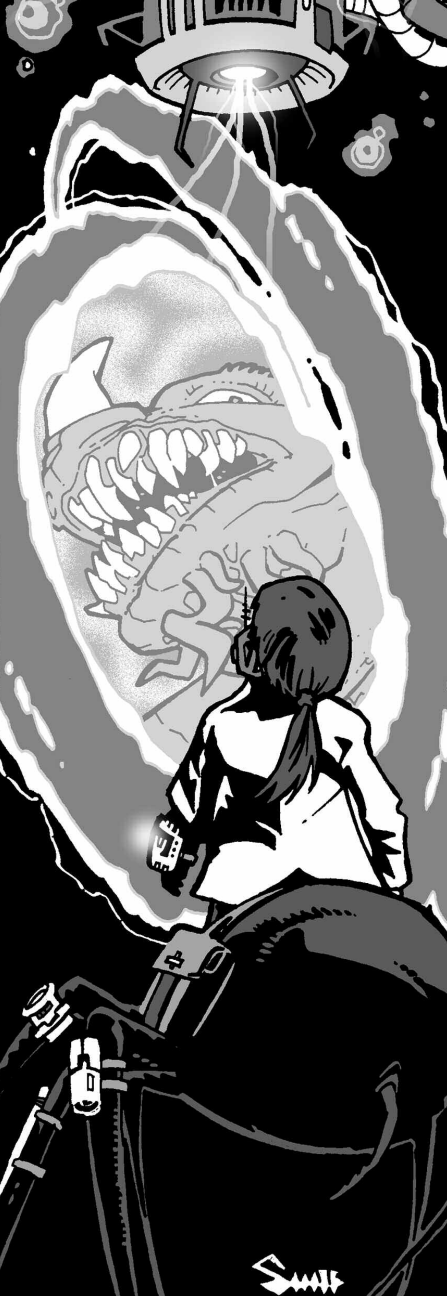
Technomancer (160 Point Template): And we have a title drop. Technomancers – a term used for anyone who does R&D concerning the fusion of magic and technology – are not merely nerds, but uber-nerds, having a -1 penalty to Strength on top of their +4 to IQ even though other non-physical character templates don't suffer the same fate. They also get about the same list of benefits and disadvantages that were present in the hacker and industrial enchanter. Their list of potential spells are filled with technological ins and outs such as Electric Power, Enchant, Conduct Power, Draw Power, Ether Static, Machine Speech, Awaken Computer, Resist Radiation, and Upgrade Computer.
Warlock (170 Point Template): A skilled wizard soldier is referred to as a warlock, because wordplay and all. Warlocks are common in all of the US armed forces, while more mage-poor countries have to either make do with only one or two per battalion at best or hire warlock mercenaries. On top of plenty of military knowledge and combat skills, warlocks get a collection of spells based on their specialization. Mechanized infantry and Air Force warlocks gain spells such as Lightning, Curse Missile, Homing Missile, and Reverse Missiles, cavalry attain spells including Beast Soother, Animal Control, Complex Illusion, and Persuasion, combat engineers have spells including Earth to Air, Create Earth Elemental, Earthquake, Mass Detonate, and Irradiate, PsyOps are capable of casting spells like Possession, Enslave, False Memory, Permanent Forgetfulness, and Terror, combat medics have spells such as Sense Life, Neutralize Poison, Major Healing, and Sterilize, meteorological warfare specialists ("weather warriors") and Navy warlocks have spells including Clouds, Rain, Hail, and Shape Water, SpecOps warlocks can choose to learn any of the spells from the first six categories as well as some choices of their own such as Control Zombie, Skull Spirits, Summon Demon, and Soul Jar, and supply chain warlocks use spells including Measurement, Clean, Repair, Seek Fuel, and Shape Plastic.

Chapter 6: Magic and Society
Are you prepared for the pure, undiluted High Concept Discussion chapter? I know I definitely am after going through character stuff.
The Younger Population
On top of magical healthcare increasing the average life expectancy, the discovery of the formula for youth potions by Chinese alchemists in 1972 suddenly revolutionized the lives of those willing to pay money to be forever young. The entire issue has already created controversy. Debates have raged over whether or not retirement should be based on actual age of physiological age and the question of whether or not medicare and social security should cover elixirs of youth, various groups have protested the concept of religious leaders and monarchical leaders becoming effectively immortal figureheads, and the CIA is having apoplectic fits over the fact that communist leaders such as Fidel Castro and Deng Xiaoping can't simply be assured to die of natural causes. And, of course, there's the creepiest question:
GURPS Technomancer posted:
Another question troubling society is whether the age of majority and age of consent should be based on chronological or physiological age. Wealthy people may make themselves 16 again, but can they still vote, drink, drive or have consensual sex if their physical age drops below the limit? Can porn stars or strippers who “youthen” to 13 still do adult shows? Police and legislators struggle to keep up with widely varying community standards and test cases in the higher courts.

Agriculture and Fisheries
With spells like Heal Plants, Bless Plants, Plant Growth, and Rain, the farming business is booming with the mage-heavy populations of North and South America. Spells like Beast Summoning and Fish Control have made it easier to get the fish to come to the fisheries, as well, but this has create the unintentional side effect of making overfishing even worse than it already was.
Architecture
Magery has actually turned back the clock on architecture in some ways. Gone are the highrises of metal and glass, skyscrapers instead being made out of hard rock with Create Stone and Shape Stone in what has been dubbed the neo-Gothic revival style. Statuary is also extremely popular thanks to the same spells. Meanwhile, Earth to Air has allowed for far greater capacity for tunneling, allowing for cheap underground structure creation. Some locations, such as Edmonton in Alberta, Canada, even have entire second cities beneath the one that is seen from ground level.
Business
There are three types of magical business that are common in the world of Technomancer. On the small end are Johnny One-Spell shops, named after a popular cartoon character who presumably only knew one spell and may possibly be the brother of Johnny Five-Aces. A Johnny One-Spell shop is a walk-in store staffed by either part-time mages in high school or college, or non-mages who utilize magic items to do the work. While a lot of these quick and cheap service shops are local, some are popular enough to have become franchises. Some examples of Johnny One-Spell chains and the spells they focus in include Body Boutique (Alter Body), Brownie Dry Cleaners (Clean), Doc Hermes (Minor Healing), and Petfinders (Beast Seeker).
Retail magic item shops sell magic items. Obvious, but true. Magic items can vary wildly in price, from $50 for a Berkely Grimoire on CD (a CD containing all spells from GURPS Basic Set) and $150 for the Working Handbook of Applied Thaumatology on CD (all known spells on CD) to anywhere between $144,000 to $700,000 for a flying carpet. There's still enough of a market on even the expensive items that there are various chains that sell magic items, nine of which are given a brief note. Abracadabra Books sells grimoires and occult literature, Cyberscrolls does the same for magic on CD and magic-enhanced computer parts, DuPont Dealerships sells flying carpets, Emperor's New Clothes rents costumes that cast illusion spells, J.W. Wells is an all-purpose magic item department store for magic items $3,000 or less, Kabbala Robotics sells golems and animated objects, Rent-a-Rug rents flying carpets, Spell Shack sells various wizard tools such as powerstones and scrolls, and Wizard's Tower is the fancy-schmancy version of J.W. Wells that sells magic items up to $10,000 in price.
Finally, you've got magical contractors. Such mages for hire are paid either by how much energy their spell costs if it's a one-spell job, or by day if that's more relevant. The wage for a Magery 3 contractor is a not too shabby $750 a day, and even a Magery 1 contractor still gets an okay $250 a day. Need ice off your roads, some water on your crops, or a clear day for your football game? Call Cloudbusters America, they're weather control and weather protection experts! Want a really secure business? Hermetic Wards Incorporated will set you up with windows that have Protection, Warding, Drain Mana, Fireproof, Pentagram, Scryguard, Scrywall, and Spell Shield slapped on them. Humane pest control? There's even a contractor for you there, as Rico and Sons can just Vermin Control your problem pests away.
Fashion and Body
If you're rich enough, you can get all sorts of fancy clothes on the magical market. Things like shoes of Haste and permanently Clean suits are popular with the elite, as is the intentionally risque practice of casting Illusion Shell to make it look like you have clothing on when you are in fact buck naked. There's also the near complete replacement of traditional plastic surgery with Alter Body and Alter Visage. These spells have also created some controversy, however. There's a whole load of debate rolling around about the use of the spell to recreationally alter race and sex, as well as make chimera halflings look human or vice versa.
Law and Order
Speaking of debate, let's talk criminal justice. American courts have several rules concerning magic utilization in the courtroom. The first is that the Compel Truth is always cast for witness testimony. Not only is it always accurate if it isn't resisted, resisting the spell creates an obvious sensation of feedback to the mage, at which point the individual is held in contempt of court. Eyewitness testimony still isn't perfect even with this spell, however, given the existence of various forms of magic that fool the eyes and other senses, which means that forensic mages are just as important to the process of justice. Outside of court, Compel Truth and similar spells such as Mind Reading, Mind Search, and Soul Rider all require informed consent. Wizard Eye, Wizard Ear, Glass Wall, and other magical surveillance spells follow the same legality rules as wiretapping.
Where there's law, there's also lawlessness, and there's plenty of nefarious uses for magic. Criminals can use the Exchange Bodies spell to literally steal someone's life (though this is rarer than most forms of crime due to the simple fact that no one actively teaches the spell, making it difficult to cast), Copy spells to counterfeit, Ethereal Body and Teleport for breaking and entering, murder and then resurrect people (often illegal immigrants) as zombies for costless labor, and use mind control spells for all sorts of no-goodery. The last category is so prevalent, in fact, that nearly all psychologists and security officers are trained to cast Aura readings to check for supernatural coercion.
Lastly, one of the strangest ways that laws have been touched by magic is the subject of animal rights. Beast Speech and shapeshifting spells means that empathy for animals is stronger than ever, and movements to prevent inhumane cruelty have gained a lot of traction. Animal testing still exists, but makes heavy use of Beast Speech and Aura spells to check on the condition of the test subjects.
Manufacturing and Industry
While mageworkers and industrial enchanters were already discussed last chapter, there's even more to note about the subject of magic in the workplace. Grids enchanted with Purify Air are utilized to lower emissions both from manufacturing plants when placed over their stacks, tiny parts are a lot more accurate due to various vision enhancement spells and the Inscribe spell, Shape Metal makes even titanium a viable building tool, and Find Weakness at the end of the line ensures quality control. Oh, and speaking of metals, Breathe Water has allowed for underwater mining to be A Thing for Mexican and American companies.
Enchantments on actual mundane products tend to be limited to specific parts, rather than attempting to enchant the whole device at once and squander more personal energy and money than need be. An example given is the good old automobile: you enchant the exhaust with Purify Air, windows and seat upholstery with Clean, and voila. The bigger an item is, the more cost effective it is to enchant it piece by piece rather than as a whole, and by the time you get to something like a jumbo jet you can stuff a lot of small enchanted parts on it without inflating the price all that much.
Medicine
As stated back in the medical professional entry of last chapter, medicine has benefited greatly from the presence of magic. Many traditional diseases have been pushed to the brink of extinction, and even afflictions that can't be cured by Curse Disease such as cancer and genetic ailments seem like they may have a cure with the further development of magical gene therapy. Of course, not everything is sunshine and roses. Just as antiobiotic resistance has evolved in real world bacteria, there is an uncommon but active threat from Mana-Resistant Diseases, or MRDs. An MRD is a normal bacteria or virus that has developed a level of the Magic Resistance advantage. One of the most deadly cazes was a strain of influenza with Magic Resistance 4 that cropped up in Guatemala in 1997, but MRDs can potentially have up to Magic Resistance 6.
Also present are new diseases that are entirely supernatural in origin. Vampiric leukemia has no cure, and even the alchemical elixir code-named Alucard that was created to combat the disease can only postpone its effects rather than stop it entirely. Ambulatory Necrotic Plague is immune to all forms of traditional medicine and Cure Disease, and can only be stopped if an Exorcism spell is cast in time to remove the undead bacteria and followed up with an Instant Regeneration spell to stop and reverse the tissue necrosis that occurs even without the zombie part of the disease. There is also Mana Resistance Deficiency Syndrome, a disease that isn't associated with a template from the bestiary chapter but is nonetheless just as insidious, and also totally isn't a play on AIDS at all, nope, not at all. You catch MRDS (not to be confused with MRDs) by getting mana from an already tainted person, at which point it begins to attack your supernatural immune system. A person who has caught MRDS has to make a Health roll every month or gain one level of the Magic Susceptibility disadvantage. This means that while the disease isn't immediately fatal, you slowly become less and less able to resist spells or magical diseases. The only known cure is to spend time in a mana-void region, eventually starving the disease of the supernatural sustenance it requires.
Military Science
While magic on the battlefield is obviously useful, warfare has yet to meet a mage who can outsmart bullets. While individual mages can cast Missile Shield, it is extremely cost ineffective to get them enchanted onto enough items to aid entire armies, and even the best Missile Shield still won't protect you from a mortar shelling or airstrike. Where magic truly shines is in various support roles. A support mage can cast accuracy-boosting spells on their allies, golems allow for an overall reduction of humanoid boots on the ground, and while you may not be able to enchant every soldier's kit, you can certainly equip a tank with spells like Fortify and Missile Shield. The US military also has several orbital platforms that can strike with "kinetic kill devices", which are literally just onboard mages shooting boulders from space to create artificial meteor impacts.
Psychology and Psychiatry
As with physical medicine, the world of helping the ind has benefited greatly from magic. Aura and Sense Emotion spells can be freely used to quickly discover someone's general mental state, and the Mind Reading and Mind Search spells can be further utilized with consent to get an even greater psychological profile. Alter Body spells also allow for transgender men and women to receive far quicker and more efficient treatment than hormone therapy, as well as deal with other forms of dysphoria on a case by case basis. Of course, since people are people, there's also a controversial side to psychological magic. The utilization of "thaumaturgical behavior manipulation" (read: mind control and alteration spells) by psychiatrists is a massive minefield, even when it's done consensually. While the use of the Great Geas spell to remove addictions and self-destructive habits has gained some ground, there are far more disturbing implications when there are homophobic lobbies demanding that mind control spells be used for gay conversion therapy and studies that indicate attempts to cure PTSD with Permanent Forgetfulness or False Memory spells may backfire and cause even more psychological harm than good when inconsistencies in the subject's memory turn up.

Pure Science
A section about the 'hard' rather than 'soft' sciences, if you couldn't figure out what that title meant at all. Zoologists have benefited from the Rider Within spell to covertly watch animals from inside one of their own, geologists and palaeontologists can use Earth Vision and Walk Through Earth to observe their subjects without even digging them up, and laboratory work has benefited greatly from Cold, Heat, Measurement, Purify [Element], and Seek [Element] spells. Perhaps the greatest scientific field that has benefited from the magical revolution, however, is astronomy. Teleportation spells broke the barrier between Earth and the heavens wide open, with mages being able to just pop building materials and golem or suited workers into orbit and then to the moon. Various space stations and moon bases now exist, and most commercial satellites can be reached by teleported shuttles for prices similar to a first class airplane ticket. Greater distances are infeasible for teleportation, but are nonetheless possible with a combination of NEMA reactor-equipped spacecraft and mages casting Create Air, Purify Air, and various other utility spells. Plans for a twenty-one person shuttle trip to Mars to create a permanent base on it have neared completion.
Religion
The topic of magic splintered the Abrahamic faiths beyond their already divided denominations, with moderates that accept magic being flanked by orthodox and fundamentalist groups that see magic as a sin (though congregations sometimes unintentionally become a hub for ceremonial magic) and liberal reformists that feel magic should not only be embraced but also incorporated directly into religious practice. In all the theological confusion, other religions have swept in to pick up the doubtful individuals. New Agers, Wiccans, and neopagans have all seen a surge in membership, as have practitioners of more magic accepting religions such as Haitian voudon, Santeria, and Hinduism.
Sports
Traditional sports have remained mostly unchanged in their active practice, but not necessarily in their execution. Teams now hire referee mages to make sure that illegal spellcasting or alchemical elixir use isn't happening, various weather mages compete for big weather-warding gigs like the Superbowl or FIFA cup, and contact sports have become even more violent thanks to healing spells keeping most damage from being permanent. Sports also have segregated leagues specifically for chimeras and chimera halflings to avoid any unfairness towards human players from their opponents having boons like cat reflexes or a giant spider for an ass. Chimeras have protested the fact that chimera leagues are often underfunded and intentionally played up as novelty acts in a way that some find uncomfortably close to old school freak shows.
Entirely new sports have also arisen in the post-Trinity world. On top of horses and cars, racing now adds flying carpets and dragons to its repertoire of variants. On the team sports side, there's a new form of basketball known as airball that relies on Levitation spells to reach a particularly high net. Creation safaris are a new form of hunting based around the Create Animal spell, effectively allowing you to kill whatever animal you want regardless of what its endangered species status may be, the only drawback being the whole caveat that you don't get a trophy since a slain Create Animal construct disappears entirely. Rarer are the controversial creation safaris that go after the most dangerous game, using Create Warrior to allow for legal human hunting in areas that actually allow the sport. Finally, there's spellboxing, which is just a fancy way for saying wizard duels.
Transportation
With teleportation being largely tied up with the space industry and considered too precious and pricey to use for other causes, there is still a large need for good old vehicles. Most vehicles are now enhanced, of course, from ships powered by NEMA reactors to high end cars and motorcycles utilizing mana-fuel engines. There is also the whole matter of flying carpets. Flying carpets fall into a strange niche, slower and easier to use than a jet plane but pricier than an automobile. They mainly fill the roles that helicopters do in the real world, as well as being popular with wealthier individuals and utilized for city "air taxis" that have fare costing about twice as much as that of the ground variety.
Next time in GURPS Technomancer: We talk people and places as we cover organizations and a few key locations in the final two chapters of the book. Expect cops, criminals, and corporations. Also, this guy:
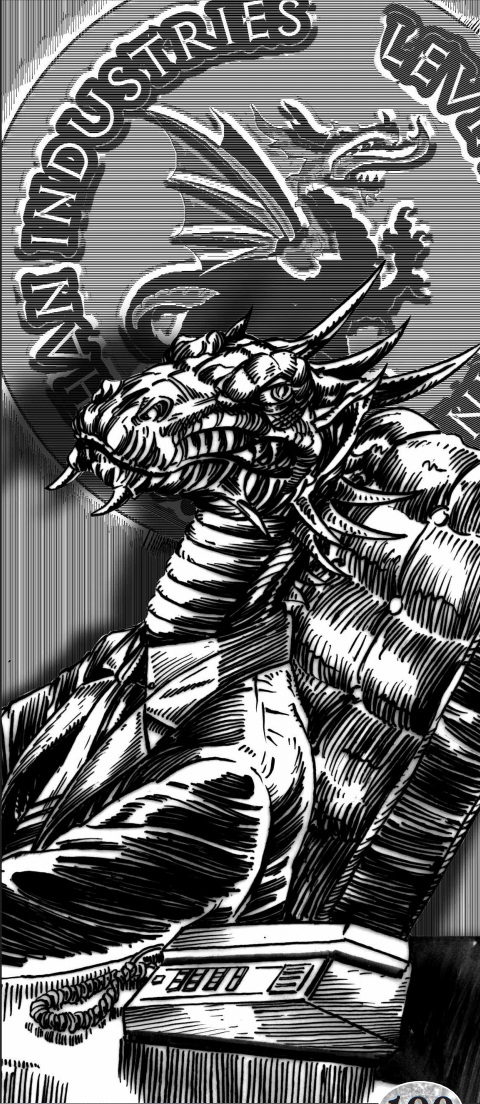
Chapter 7: Organizations
Original SA post
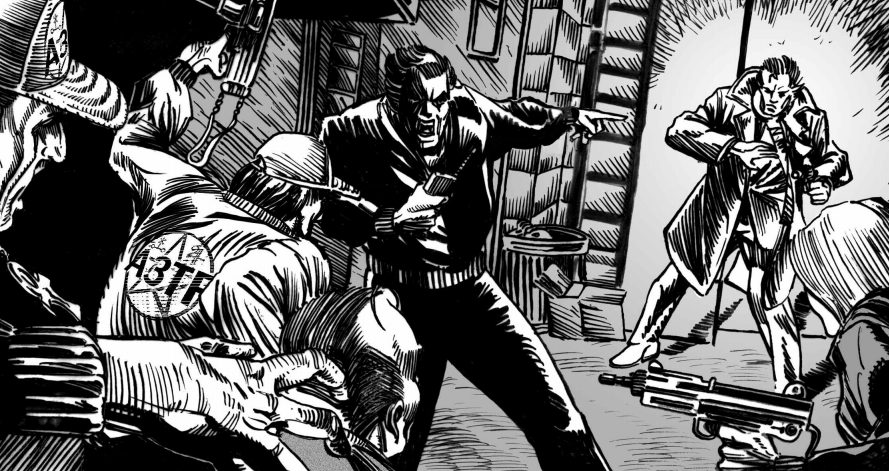
Chapter 7: Organizations
Bureau of Alcohol, Tobacco, Tactical Talismans, and Firearms (A3TF)
On top of what the real ATF regulates, the A3TF deals with the regulation of "tactical talismans", classed as any magic item capable of producing physical harm or dysfunction. They also cover magic item smuggling and supernaturally-induced arson. The NRA and their kin in the world of Technomancer see combat wands and other damaging magic items as a direct extension of the second amendment, and arguments over tactical talisman control get just as nasty as ones about gun control.
Centers for Disease Control (CDC)
The CDC still deals with diseases, of course. And since vampiric leukemia and ambulatory necrotic plague are diseases, that means the CDC gets to have its own special team of undead slayers. Hazardous Material and Entities Teams, or HazMETs, go out and personally take care of the threats of entities classified as "ambulatory biohazards", including vampires, toxic zombies, atomic liches, and chonchons. HazMET teams also get called out when there is a need to have wizard battles with bioterrorist mages.
Central Intelligence Agency (CIA)
While they're best known as a spy agency, the CIA in the world of GURPS Technomancer is actually criticized for lack of spying, as they have spent a lot more of their budget on trying to figure out new surveillance and countersurveillance spells rather than recruiting foreign operatives and gathering intel.
Drug and Alchemy Enforcement Agency (DAEA)
The DAEA is at the front of the War on Drugs and Alchemy, an ongoing fight that started with cartels on the Mexico border but has since spread nationwide. Libertarians (and presumably other left wing groups, but only libertarians are mentioned by the text) have contested the fact that DAEA offices now have access to large amounts of conventional and magical firepower and large legal jurisdiction, and raids of local mom and pop elixir shops have lead to some civilian accusations that the organization is on the payroll of Big Alchemy. Their agents don't really care, though, because...
GURPS Technomancer posted:
They know what crack and spelljack can do to a neighborhood, and see firsthand the horrific “brain labs” where society's lost are brain-leeched to make PHTP. When they hear of a cop ripped apart by gangbangers supercharged on illegal combat elixirs and PCP, they have no qualms about shutting down the back-alley shop that makes the stuff.
Excalibur
Remember the Star Wars project? Well, in the world of GURPS Technomancer, Reagan instead came up with this black ops project, and unlike Star Wars, it succeeded. Ronnie was terrified at the fact that the USSR figured out how to create kinetic kill satellites soon after the USA did (because dropping big rocks is apparently a difficult discovery), so he ordered the testing of a new form of satellite that would be able to break through even the extremely powerful Force Dome spells that the kinetic kill satellites are enchanted with. The result is the Excalibur: a satellite containing a nuclear warhead that, when detonated, powers twenty-four mana-active lasers that drain the Force Dome while the blast's concentrated radioactive beam itself incinerates the juicy mechanical innards. While nuclear detonations in space don't threaten causing a Hellstorm event like one in the atmosphere would, it is still technically against the Test Ban Treaty of 1953, so the Excalibur is kept very much under wraps to avoid international outrage.
Federal Bureau of Intelligence (FBI)
The Bureau is home to some of the world's best forensic mages. Seers attempt to predict crime sprees or major events so they can be stopped before they happen, exorcists are on hand to deal with demonological and spiritual crimes, and certain occultists on staff are trying to unravel the mystery of the Seelie. For whatever reason, most of the already short entry space for each organization is spent discussing how many individuals of various real world personnel types the FBI has.
National Astromancy and Space Administration (NASA)
A surprisingly terse entry, simply noting the actual space holdings that NASA has. I can assume that this is a result of the last two chapters detailing a lot about space travel already. Most launches by NASA are done at the Johnson Space Teleportation Center at Cape Canaveral, Florida. Astromancers there have access to immense powerstones, allowing them to channel enough energy collectively to teleport things up to five tons in weight out into orbit. Space Port Hermes is the primary space station in orbit for NASA to transport things to, and it acts a staging point for the organization's two moon bases. The Hubble Lunar Observatory is an observatory of thirty scientists that live on the far side of the moon and observe the stars, while Kennedy base is a joint NASA, European, Canadian, Mexican, and Japanese space station with a maximum one thousand person population found across forty buildings.
Paramagical Regulatory Agency (PRA)
A spinoff of the Department of Labor, Department of Education, and Environmental Protection Agency, created to deal with magical concerns related to all three of the above mundane organizations. While the PRA has authorization to shut down someone's business, they have no legal authority to deal with criminal acts, and primarily just end up providing leads for the police and FBI or aid with legislation related to the regulation of magical commerce. The Republican party has repeatedly tried to defund the PRA, to no success so far.
Other US Agencies
These poor saps only get a few sentences rather than the few paragraphs the other organizations so far have gotten. To give a quick rundown of an already quick list: the National Reconnaissance Office runs satellites enchanted with the Wizard Eye spell and send their information to the NSA and CIA, the NSA has nothing really new of note about it right here compared to what it already is in real life, the Secret Service supplies agents with magical items enchanted with Missile Shield or Reverse Missile, and the US Space Command is the Air Force's space branch for when there is tension out in the wild black yonder.
Chili Wizard
For whatever reason, chili is actually the most popular fast food in Technomancer's America, with Chili Wizard being the leading chain. Chili Wizards are easily spotted by their stereotypical wizard's tower-shaped buildings and their cartoon dragon mascot El Draco the Chili Wizard. Their chain was the first group of drive-throughs to utilize pots enchanted with the Cook spell to make restaurant-quality food at fast food speeds, and they have continued to lead the food industry in innovations surrounding the creation and application of spells related to the creation of food.

Leviathan Investment Group
Our prerequisite megacorporation, since this is a 90s game after all. Leviathan owns a lot of companies in numerous fields, has large numbers of lobbyists under its thumb, is connected to a few foreign dictatorships, and is lead by a mysterious man named Jericho Rain. Hidden to all but the corporate elite of Leviathan is the fact that Rain is actually a particularly intelligent blue dragon. He was a member of the Black Berets during the Vietnam War, where he made his living as a black market arms salesman. The fortune he made off that was what he used to pump life into a small investment firm he found and transform it into the corporate giant – well, let's be honest, corporate leviathan , because that's totally what they were going for with the name – it is today. Some of the big companies Leviathan has swallowed up include:
-
Global Hazardous Operations and Security Techniques:
GHOST is a two-edged sword. On the one hand, it trains magical security for law enforcement and corporate interests, as well as some of the best Hellhounds in the nation through their own Cerberus Unit. They even have criminal mage reform programs across the USA that they pay for out of their own pocket. On the other hand, GHOST also has a base off of American soil, down in Surinam, that acts as a mage PMC that contracts out to war-torn nations across the Third World. Whether or not they secretly have the backing of a Herculean senator from the midwest is unknown.
-
Hermes Technology:
The largest alchemical R&D and manufacturing group in America. It is a profitable venture for Leviathan, being its largest subsidiary thanks to huge money from varous elixirs and being the first to develop aerosol elixirs and sell them to the military and law enforcement groups. They also keep mysteriously having accusations against them concerning illegal alchemical waste dumping either dropped or settled out of court.
-
Leviathan Genetics:
Leviathan Genetics is perhaps most famous for being the inventors of the Transfer Pregnancy and Spellgraft spells and custom-engineered familiars, but it has so far still been a huge money sink for LIG. Still, research keeps going, combined with aggressive headhunting at mage campuses for anyone who has any whiff of talent regarding genetic manipulation. Since human genetic engineering is currently illegal in the United States in spite of their lobbying, Leviathan Genetics has a branch down in Surinam with their PMC brethren that allows wealthy individuals to fly there and request Spellgrafting or other fetal tampering for a hefty sum. Rain's ultimate goal is an "everyone will be superheroes...if they can pay" situation: not content with having Spellgraft allow children to be born with a single innate spell, he keeps filtering cash into Leviathan Genetics for the ultimate goal of being able to genetically induce Magery itself.
-
Leviathan Media Group:
A book, magazine, and compute game company, without any deep dark secrets or the like. Some of their most popular periodicals include Better Living Through Alchemy, Chimera Life and its racier counterpart Chimera Babes, Financial Wizardry, Hermetic Gardening, Popular Enchantment, and Tactical Sorcery Review.
- Sunspark Opals: A joint investment between Leviathan and Manadynamics that creates and sells watches and jewelry that have embedded Powerstones. It also doesn't have any deep dark secrets.
Manadynamics
Manadynamics was the pioneer of both industrial enchantment and the creation of Powerstones, large opal-like gemstones that hold extra mana that can be used for casting and automatically recharge themselves over time. While other groups quickly reverse-engineered the concept and courts ruled that Manadynamics could not hold monopoly on the concept of a magic rock, the company is still the primary manufacturer of Powerstones due to the number and quality they produce. Most other products of Manadynamics are the result of partnerships. On top of their jewelry business with the Leviathan group noted above, their other really big successes have been creating flying carpets with DuPont and the Harmonic Converter™ mana-powered engine with Ford Motors.
Necrotech
If you recall, these guys have been embroiled in legal controversy over their spell that lets you watch no longer running television shows. That's probably actually the least of the problems this company has had. Golems at their factories had programming to use deadly force against unauthorized personnel, necromantic waste was unsafely stored, and numerous conspiracy theories swirled around them, all leading to eroding public trust in the company. This all came to a head when a massive industrial accident at NecroTech Albuquerque in 1991 killed two of its brightest scientists and lead to a CDC investigation, which unsurprisingly found numerous health and safety violations that lead to the facility being sealed off. The combination of the loss of key personnel, its largest research lab, exorbitant fines, and plummeting stock more or less crippled Necrotech. The only reason they survived at all was a buyout by Sephiroth Industries in 1994. While merely a subsidiary of Sephiroth, Necrotech survvied and rebounded thanks to corporate restructuring and greater safety measures that got both the public and the military (for whome ghost dynamic lasers and golems were built before the 1991 incident) back on Necrotech's side.
That's not the whole story, though. Those conspiracy theories? Two of them are true, at least. Claims that Necrotech were researching interdimensional travel were true, and that research continues covertly under the leadership of Sephiroth Industries. Conspiracy theorist claims of a nefarious device code-named Soulburner were also, unfortunately, very much true. Andrew Bleys, the man who founded Necrotech and one of the two scientists who died in the 1991 disaster, was obsessed with trying to find something that could channel excess mana even better than Powerstones. His eventual decision: human souls . Thus was born the Soulburner Gestalt, a terrifying machine that is a giant tube with five hundred decapitated but nonetheless alive human heads plugged into wall sockets and writhing in eternal pain. Each head acts as a Powerstone, but their connection to the machine means they all act in unison, effectively making a ridiculously powerful Powerstone that could fuel tons of magic use. When it was discovered during government raids of the Albuquerque facility after the 1991 disaster, shocked NSA agents spirited it away and supposedly dismantled it, but kept Bleys's original blueprints secretly hidden under lock and key rather than destroying those as well. You know, just in case.

Sephiroth Industries
Sephiroth Industries began as just another one of the various Powerstone companies vying for a piece of the Manadynamics pie, notable only for managing to survive the head Powerstone company's crippling licensing fees by designing a new form of Powerstone in 1968 that was large and energy-packed enough that it could be used to revolutionize the space race. The ascent of chairwoman Elena Chapel also lead to an ascent of the company, with her decision to push more money into spell R&D leading to Sephiroth's invention of the spells Conduct Power, Draw Power, and Steal Power in 1978. Selling these spells to schools and commercial businesses for a flat rate one-time licensing fee not only made Sephiroth Industries money, but also broke the monopoly Manadynamics had on the field of magical energy.
The company now specializes in telportation-grade Powerstones, teleportation shuttles, electromagnetic-related magic, energy to mana and mana to energy conversion through their invented spells, and the products created by their subsidiary Necrotech. Sephiroth Industries is also the primary civilian provider of space transport to both space stations/satelittes and the moon, and their own massive wheel-like space station dubbed Yetzirah is planned for completion by 2005.
Other Corporations
Like those random US agencies, these are the corporations that are at the bottom of the word count barrel. American Telegraph, Telephone, and Telepathy manufactures magical telecommunications gear on top of mundane phones and the like, Boeing Hyperspace creates teleportation wands, Brujera Mexicana is the largest magitech corporation in Mexico and creates a variety of civilian and military magic items, DuPont makes Kevlar and Ectoweave™ as well as flying carpets, IBM makes both magical and non-magical computers and developed the Small Vision spell, Intel was the first to use the Inscribe spell for microlithography, Lockheed-Martin tries really hard to compete in the same sales fields as Sephiroth Industries but has only beaten them in the creation of military aircraft, and Manastar is a software developer that pioneered awakened computers and scrolls on CD.
Activist Groups
Since these guys actually manage to have a big more to them than the "other [x]" groups do, they get enough attention from me to actually pull out some bullet points rather than one rambling sentence.
-
Bothered About Magic Prostitution:
BAMP protests against the use of Create Servant constructs, plastic golems, and video entities (magical constructs created by enchanting part of a film reel, VCR tape, or CD in order to reproduce a thing that is on screen as a full-sized animate entity) as sex workers. They allege that these acts are becoming more and more common, and that legislation is needed now before things get out of hand.
-
Everyone's Against Spirit Exploitation:
Founded in 1980, EASE primarily protests against the status of elementals as tools and property in spite of their sapience, but also support privacy rights for the dead and lessened use of the Summon Spirit spell. With around twenty thousand members and strong public support, they are one of the most successful magical activist groups in the United States.
-
Greenpeace:
The most well-known "responsible" (the book's scare quotes, not mine) environmental activists. A recent incident involved French-sanctioned terrorists attacking Greenpeace after a protest of France's testing of necronium bombs in the South Pacific.
-
League of Chimera Voters:
The largest activist group in the United States with around one hundred thousand members, the League of Chimera Voters is basically the NAACP but for chimeras.
-
Nightclaw:
A New Mexico-based chimera activist group. Unlike the League of Chimera Voters, Nightclaw goes with the bash-the-fash strategy of activism rather than quiet protests and letters to city representatives.
- The Right Path: A really weird straw atheist organization. They argue that magic is inherently irrational and that hard science should be supported instead before Western civilization topples from its own folly. This would make far more sense if this was Mage and not Technomancer, where magic is in fact quite scientific and can be researched, measured, and developed like any other type of technological advancement.

Terrorists
Like activist groups, the clan of setting villains here are still more noteworthy than any of the collective Other Guys, so the bullet points are getting pulled out again.
-
Army of God:
Muslims that hate magic, the USSR, and Israel. They are supported by Iran and Afghanistan.
-
Dead Brigade:
While mostly made up of vampires, the leadership of the Dead Brigade is an atomic lich hacker named Lord Deadlady.
Lord Deadlady
. Their primary goals are beating the shit out of the CDC, attempting to force the US to repeal anti-vampire laws, and trying to create NEMA reactor accidents to create more undead.
-
Elemental Liberation Front:
ELF is a splinter group of EASE that felt peaceful protests wouldn't get elementals freed from their slavery at any reasonable rate. While only about thirty members strong, those members include elementals, chimeras, and at least one dragon, which means they aren't exactly weaklings.
-
Gaea's Guard:
A group against NEMA reactors and the proliferation of necronium products. Their main attacks are against NEMA power lines and corporate offices.
-
God's Own Army:
Like the Army of God, but Christian instead of Muslim and not supported by or turned against any particular nation.
-
Irish Republican Army:
If you lived through the 90s, you probably know who these guys are. In the world of GURPS Technomancer, they engaged in necromancy and the summoning of demons taking the form of beasts from Celtic mythology.
-
Loki's Stepchildren:
A group of radical anti-Christian neo-pagans, made up entirely of nonhuman races. They target human Christian groups for their attacks.
-
South Atlantic Solidarity Strikeforce:
A Maoist collective that have allied themselves with the killer penguins. The only attacks SASS has made have been against Argentinian bases on small Antarctic islands, so they aren't particularly demanding as far as terrorist groups go.
-
Weather Underground:
Another actual terrorist group that did horrible things in the real world in the 90s. In Technomancer-land, they have actual weather control magic.
- Wodinspear: A group of Norse neo-pagan skinheads with ties to Neo-Nazis. They hate all non-whites, including non-humans, and I can only imagine how well they react to Loki's Stepchildren given their shared religion.
Elementalist's Union
The Elementalists' Union is a union for mage laborers who utilize elemental magic. It is a powerful union that has contributed to the political careers of various Democrats and lobbyists that are pro-labor and pro-magic. The Union's biggest troubles have come from the mob, which has been attempting to infiltrate and influence the union's members in New York and New Jersey, and the protestation of their use of Summon Elemental and Control Elemental spells by activist groups.
Enoch Foundation
The Enoch Foundation is an international nonprofit that utilizes various healing, plant-boosting, and weather contrl spells to aid those living in Third World nations. After accusations of imperialism in the past, modern Enoch volunteers have taken to working with and assisting local mages and community leaders rather than ignoring them while going in all gung-ho.
Syndicado Nacional de Trabajadores en Brujera y Curandera Quetzal
A mage worker's union in Mexico....and that's pretty much it. I'm not sure why these guys aren't in the upcoming "Other Organizations of Interest" section instead of here.
Brothers of the Morning Star
A cult that preaches oneness and achievement of spiritual clarity, even claiming that non-mages can gain Magery by rising through the ranks and achieving their own personal divinity through cosmic enlightenment. The Morning Star's leaders claim that their teachings come from Ozymandias, a spirit who is the last survivor of a mighty civilization that was once found on Venus but was destroyed after all but Ozymandius strayed from the path of enlightenment. In truth, Ozymandias is just a malebrachne demon, albeit one who has managed to get an impressive following.

Church of the Knights of the Apocalypse
A splinter group of Southern Baptists who adapted their premillenial dispensationalist ideas to the magical world. They see chimeras and undead as part of Gog and Magog, along with Cuba, Russia, and Canada (change that to Russia, China, and Iran and you more or less have a non-magical version of what my parents taught me, so not too far off so far). Chimeras in particular are believed to be sired from incubus sperm, and thus carrying the spirit of Satan. The signal of the Rapture and the Apocalypse after it is said to be a third Hellstorm in Jerusalem some time in the next century, and the Knights feel it is their duty to save as many souls in the time before and block the 'forces of darkness' from having too much support when the end does come. On top of standard fundamentalist right wing political positions, Knights urge their members to avoid and boycott chimera-owned businesses and support legislature that directly or indirectly hampers chimeras' civil rights, especially their ability to breed. Women in the church who have the rare misfortune of a pregnancy that spontaneously has the fetus develop into a chimera rather than a human typically either abandon the baby or have an abortion in spite of the church's pro-life stance – both in secret, of course, to avoid abuse and accusations of devilry.
The Rachelites
Almost the polar opposites of the Church of the Knights of the Apocalypse, the Rachelites were created by Rachel Curwin, a woman who claimed that the voice of God spoke to her and told her to take up "the sword of Alamogordo" (magic) and smite those who would threaten peace and justice. Rachelites are entirely made up of mages who believe that Curwin's vision was both true and a commandment from God that deemed magic a tool of the righteous. They join various law enforcement and military groups to enforce the law, and are big supporters of the US government. You probably shouldn't talk about the Hellstorm, though – they consider the name to be sacrilege, and instead refer to the Hellstorm as the Eye of God or the Divine Whirlwind.
The Condor Group
The Thule Society were Nazi mystics that had no magical talent whatsoever, since there was no such thing as magic yet. As the Third Reich collapsed in 1945, terrified Thule Society priests hiding deep in the mountains of Bavaria attempted to contact Hitler's ghost in a desperate attempt to figure out what to do. Surprisingly, it worked: the Trinity test had made magic real, and their ceremonies suddenly had merit. Hitler pointed them westward, destined to create a Fourth Reich in the New World. Their seance answered, the Thule priests made the pilgrimage to Argentina along with other Nazi escapees and created a front for themselves as a financial and consulting firm called the Condor Group. Using the Exchange Bodies spell, they hid wanted criminals such as Otto Skorzeny, Martin Bormann, and even Joseph Mengele behind entirely new faces, and through their deceptive charms they worked their way into the good graces of Juan and Eva Peron. Saving Eva from a life-threatening illness and teaching her the ways of the mage sealed the deal for good.
Nazis now effectively rule Argentina, the power behind the throne of the immortal Eva Peron. Decades of indocrination to Nazi ideology, eugenics programs, and armies of ghost U-Boats and their damned crews raised by Condor Group necromancers ensure that the Nazi legacy will continue, and the combined use of Steal Youth and Exchange Bodies spells has meant that the original Thule priests are still around as well. They even have Hitler at their side – sort of, at least. A ghost that is believed to be Hitler is kept in a protective glass sphere, but all he does is scream and mutter nonsensical words and phrases, seemingly having been driven even more mad by whatever happened in the afterlife.

The Cartels
Operating primarily out of Colombia and Mexico, the Cartels are well-known for their large hand in the drug trade. The sheer amount of magic that makes crossing countries unnoticed easier has forced the DAEA to abandon hopes of winning the War on Drugs through border control. Instead, they focus on policing American streets and aiding Mexican and Colombian efforts to fight the Cartels on their native soils. The main products the Cartels move are cocaine, spelljack (cocaine infused with crushed powerstones that causes the user to cast spells more effectively, feel overconfident, and have glowing red eyes; being addicted to spelljack is a -20 point disadvantage), and the infamous Purified Human Theokinesis Protein. PHTP is created from theokinesin, the cerebral chemical that is produced in tandem with Magery. Taking PHTP increases a character's Magery advantage by one level or grants Magery 1 to a non-mage for the twenty-four hour duration of the drug, as well as producing , but overdosing can actually lead to permanent loss of a level of Magery. The thing that makes it illegal, of course, is the fact that you need to hack up someone's brain to get at, and Cartel manufacturers have started to run kidnapping and murder rings just to make PHTP.
The Mafia
Mafia activities are mainly focused on protection rackets that target small magic item shops and construction businesses, magic-aided blackmail, mind control magic, and prostitution of chimeras and succubi/incubi. They have also begun to smuggle magic items from America to Europe, as Europe has a fair amount of tariffs that make their magic item prices overall more expensive. Mafia wizards are called Bernandanti and specialize in mind control and necromancy spells, with Soul Jar being actually enforced on members of the families to ensure their loyalty.
Triads
Triads are best known for exploiting Asian immigrant sweatshop workers and smuggling drugs, firearms, and alchemical elixirs across the Pacific in both directions. They also directly compete with the Cartels for PHTP production and distribution. Some Triads gangs are lead by dragons, who gain high status thanks to connections they made in the east Asian underworld during the Vietnam War.
Other Groups of Interest
The Vatican has a group monitoring priests and nuns that are mages and coordinating Catholic mage training, Mexico's feds have a decent number of mages, and Mossad uses golems and primarily targets Middle Eastern countries and Argentina. That's pretty much the summary of the very short "other groups of interest".
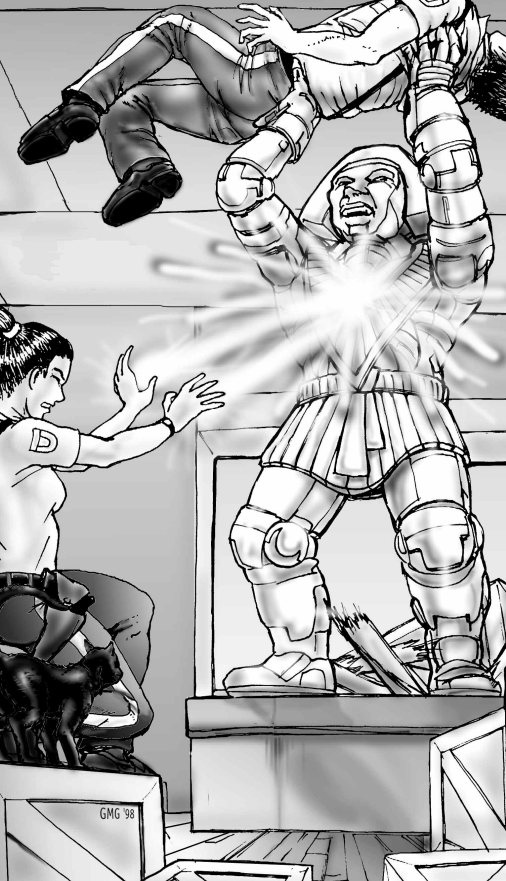
Chapter 8: World of Wizardy
The very last chapter of GURPS Technomancer gives us a brief gazetteer. Almost all of it focuses on the heavily mana-touched areas of Trinity's Shadow (the USA, Mexico, Central America, the Caribbean, and southern Canada) and the Antarctica Hellstorm (Antarctica, southern Argentina, and various tiny islands). Since those areas are the ones with the highest number of mage births and supernatural entities, they are given far more attention on what has happened to them, which I guess is reasonable but at the same time a bit sad at the same time, given that I'd love to see what certain other nations do with their smaller but nonetheless present mage populations.
Places of Power
Certain places that have long (Victorian era-long at the least) been associated with the mystical and the arcane, such as Easter Island, Stonehenge, and Buddhist temples. These aren't listed in any detail, with the book instead asking us to look at GURPS Places of Mystery and take inspiration from it. I may just do that later on down the review line, book, thanks for the suggestion.
The Manabelt
Covering a two hundred mile radius that covers most of New Mexico and parts of west Texas and northern Mexico, the Manabelt was the epicenter of the magic blast of the Triniy experiments. The results were insane, to say the least. In most of the world, one in a thousand people are born with Magery 1, one in ten thousand are born with Magery 2, and one in one hundred thousand are born with Magery 3. In most of Trinity's Shadow and the Antartica Hellstorm, those numbers are one in one hundred being born with Magery 1, one in four hundred with Magery 2, and one in one thousand with Magery 3. People in the Manabelt have six times as many mage births as the rest of Trinity's Shadow, and the otherwise rare chimera births are just as high as mages. Unsurprisingly, people flock to the Mana Belt for both agricultural and industrial business, chimeras gather there due to safety in numbers, and non-mage tourists who want a taste of magical power travel there to be able to use magic for a brief period of time. Some particular locations of note within the Manabelt are also given.
-
Alamogordo:
Near the epicenter of the original blast that created Trinity's Shadow and the Manabelt, Alamogordo is both a major magic agricultural center and military location. On top of White Sands Missile Range being converted to a slace teleportation center, it is the location of Camp Merlin, the wizard training ground for the US Army.
-
White Sands National Monument:
A gypsum desert that is best known for having an all-white subspecies of basilisk. The park is open unless tests are being performed at the White Sands Missile and Space Teleportation Center.
-
Trinity Site:
Sixty miles northwest of Alamogordo, the Hellstorm still rages where it was born. The Army keeps the area under lock and key, since it's probably in everyone's best interests to avoid any deaths in a terrifying mess of radiation, super-high mana, hurricane-force wind, and lightning.
-
Albuquerque:
The second largest city in the Manabelt, Albuquerque is home base for major magical corporations including Sephiroth Industries and its subsidiary Necrotech and Hermes Technology. There is also the large mage's college of the University of New Mexico, SpecOps dragons and high-power stealth fighters at Kirtland Air Force Base, and a burgeoning tourist industry. The city also has a darker side in the Lower Central Avenue district, which has become known for such things as vampire snuff films, large-scale succubus prostitution, and PHTP trade.
-
Carlsbad:
This small town is best known for the things around it, rather than anything in and of itself. The Living Desert Park is a nature-rich wonderland famous for its walking cacti (close to zombee cactus, but without the undead or bee control parts), Carslbad Caverns has numerous bats and urban legends about vampire clans in its labryinthine depths, and the controversial Waste Isolation Plant and its salt domes packed with mana-active waste.
-
El Paso-Juarez Metropolis:
The most populated Manabelt city is Ciudad Juarez, partnered with the Texan city of El Paso as a "twin cities" urban metropolis. El Paso is famous for having the prestigious magical academy of the University of Texas at El Paso and the headquarters of Manadynamics, and Ciudad Juarez balances a large tourist industry and magic item factories with a reputation for being heavily corrupted by the Cartels.
- Roswell: Roswell, New Mexico, is a mostly idyllic ranching town and the head of Chaves County. It is home to the New Mexico Military Institute, a military cadet school with around a thousand students pulled from high schools across the country, and also supposedly where Seelie faeries manifested in 1947 and were captured by the government and taken away from Roswell to Area 51.
Mexico
Mexico has become a powerful industrial nation thanks to the manufacture of magic items, magical healthcare, and plant magic boosting its agriculture, though it still lags behind the United States in wealth. There is also the stumbling block of unrest with the native peoples in Chiapas after a revolt spurred on by the lack of magical aid in the region, as well as the ever-present issue of the Cartels. Mexican mages nonetheless get a lot of business from various nations that are on less than friendly terms with America.

Central America and the Caribbean
While this is a multi-part segment like several before, it's unfortunately not really interesting enough to have a bullet points party. The nations of El Salvador, Guatemala, Honduras, and Nicaragua can all be summed up as "shit's fucked with cycles of left wing and right wing violence that is often fueled by Cuban and American interests", and Belize merely gets a note that it has a fair bit of tourism and geomancers looking for oil. That just leaves the two notes on the Caribbean to cover. Haiti was one of the few Caribbean islands that didn't fall under Trinity's Shadow. This forced Francois "Papa Doc" Duvalier and his successors to hire mercenary mages from Mexico to help prop up their rule, until the US broke everything apart and restored democracy in the early 1990s. Meanwhile, Fidel Castro is kept strong and healthy in Cuba thanks to youth potions, while a network of state-sponsored magical education attracting mages that in turn help provide medical care and infrastructural work. Cuban mercenary mages are popular with the USSR and its allies.
Canada
Most of southern Canada was under Trinity's Shadow, save for Quebec and the Atlantic provinces. This has created even greater tension amongst the Quebecois, who are totally serious about separatism this time you guys. Its magic healthcare system is the best in the world, its variant of NEMA reactors known as CANDU reactors are popular exports, and Canadian wizards are often made part of the UN Peacekeepers.
Argentina and Tierra del Fuego
Argentina has powerful magical agriculture, healthcare, and military might. It also has a fascist leadership of the ageless Eva Peron and her Nazi allies, which is not so good. Enemies of the state are unpersoned, murdered, and then animated as zombie laborers that toil away in the country's mines and factories. Even worse have been the injustices made against the native Ona and Yaghane people of Tierra del Fuego, many of whom were moved to the Argentine mainland under the pretense of safety concerns regarding magic radiation, only to be tortured and used in horrific experiments by Dr. Mengele. Israel and the United Kingdom have repeatedly hinted to the United States that Nazis are in Argentina, but for whatever reason there has been no severance of diplomatic ties.
The Mundane World
Socialists in Europe have accused America's magic supremacy as an imperialist threat that leads to magical pollution, mana-resistant diseases, vampirism and other undead plagues, and the enslavement of elementals, but most of the rest of the world is ultimately ambivalent about the subject of magic. The only two countries detailed here are Vietnam and Surinam. The former s an authoritarian regime that has yet to recover from the magical scars of the Vietnam War, while the latter was taken over by a mercenary's wife named MAria Hawker, her mage mercenary flunkies, and her Dutch allies.
Creatures of Enchantment
I actually completely forgot that this tiny segment at the end existed, and it's honestly not hard to figure out why. This is more or less the bestiary of non-playable magical entities, And each entry has one or two sentences at best followed by a terse stat block. Basilisks are spiny Gila monsters that can cast Flesh to Stone, great crimson manticores are mutant mountain lions with rudimentary sapience, a venomous stinger on its tail, red fur, and a human-like face that can parrot random phrases it hears from humans it has preyed on, jackalopes are antlered jackrabbits that are aggressive during their mating season, walking cacti are vaguely humanoid and actively carnivorous cacti that stand 15 to 20 feet in height and impale prey on their spines, albino alligators are massive white alligators found in sewers across America, and leviathans are immense eels with reptilian heads that are known to attack ships.
Next Time, in GURPS Technomancer: Looking toward the past and the future with brief coverage of the Vietnam War adventure Technomancer: Strange New Guys, a look at mentions and legacy traits of GURPS Technomancer found in GURPS Fourth Edition, and my own final thoughts on the setting as a whole.
Extras
Original SA post
Welcome to the last post of GURPS Technomancer. It's time to tie up the last loose ends before we close the book on this tale and look forward.

Looking to the Past: Funny New Guys
GURPS Funny New Guys: Technomancers in Vietnam was a fifty page PDF adventure and pseudo-sourcebook that was produced in 2004, near the very end of GURPS Third Edition's lifespan. On top of talking about troop deployment strategies and going into more depth about topics covered in GURPS Technomancer proper such as the Black Berets and Kennedy's "Spell Gap" speech that spurred on the magical revolution, providing some mini-templates (what GURPS Fourth Edition would come to call lenses) to add specific military training to any character template, stats for various vehicles, weapons, and hazards of war, and a triad of native wildlife to endanger soldiers (the reticulated python, leopard, and green viper, to be specifc), the biggest thing Funny New Guys presents to us that isn't the adventure is a rather shocking revelation about Vietnam: it actually received some of the manafall of the Antarctica Hellstorm during the 1949 spring monsoons. We will sadly never know what kind of chimeras came about in Vietnam, as they were systematically exterminated, both by peasants who were terrified at these strange monsters and the Vietmin because...just because. Mages were spared, however, and eventually became a tool for the Vietminh to use to overthrow the French yolk. We also learn that there were ten yellow dragons (yet another ally-coded designation for the same green-scaled dragons that everyone else uses) gifted by Nixon to Saigon after the war ended, but they aren't really important at all as eight of them were killed when they took part in a military coup in 1983 and the other two fled into the jungle and have never been seen again since.
The adventure itself puts the players in the role of grunts in the Fox Company, a unit of the 101st Spellborne Division during 1967. Their superiors are the Jazz-loving and overconfident hardass Captain Dale Muncie, fiery-tempered 1st Seargeant Larry Otis, drunkard, tobacco addict, and master of all types of firearm Staff Sergeant Tim Kapecki, and West Point glory hound 2nd Lieutenant David Henderson. There are also stats for Earnest "Fluffy" Faran, a fox chimera corporal who is a crack shot sniper but ultimately insecure after the anti-chimera prejudice he's experienced and eager to get back home to Texas. The course of the adventure takes place over several patrols of the unforgiving Vietnamese rainforest, the last of which ends in a firefight against heavily armed Viet Cong and a Howitzer they plan to use to destroy the base the players have been stationed, all during a heavy thunderstorm. Wounded characters receive a Purple Heart, and all of them receive the respect of the Fox Company's leadership as they are go from FNGs (which the book claims to stand for Funny New Guys, hence the title, but I'm fairly sure that first letter is a less pleasant word) to honoray "Fighting Foxes" in the eyes of their superiors.
Funny New Guys is written by Ed Wisniowski, writer of GURPS Monsters, GURPS Villains, and the In Nomine book Liber Reliquarium. While he doesn't do anything drastic with the setting, for good or for ill, the supplement doesn't really feel all that out of place either, and the parts that expand on existing Technomancer concepts honestly feel like they could have been written by Pulver himself. Wisniowski also doesn't stumble into the pitfalls of glorifying the Vietnam War as a just one in spite of the explicit American victory in the Technomancer universe, very much emphasizing the "war is hell" aspect of the entire mess.
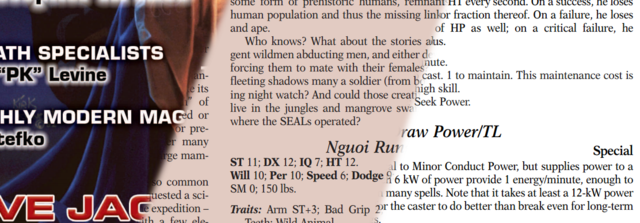
Looking to the Future: Technomancer in GURPS Fourth Edition
Unlike some other 90s properties, it's very improbable that we'll ever see a GURPS Technomancer 20th Anniversary in 2019 or anything. The reasons for this are twofold. First off, the actual production climate of GURPS has changed a lot since the 80s and 90s. Gone are the days where you'd have a few hundred pages dedicated to a specific topic like ancient Egypt, the Napoleonic Era, or prehistoric life, and even longform settings have been abandoned for the most part. Steve Jackson Games still produces large print books once in a blue moon, like the upcoming GURPS Mars Attacks and Fourth Edition version of GURPS Discworld, but for the most part they have shifted their focus to smaller PDF releases around thirty to fifty pages, which I assume is financially viable given that they keep doing it.
Second, and probably more notably, the setting was technically updated. While GURPS Reign of Steel and GURPS Transhuman Space are settings that received small but proper conversion books, Technomancer was apparently less of a priority, as its 4E update was a few paragraphs in GURPS Infinite Worlds. One of two major setting books that were put out for Gurps Fourth Edition, GURPS Infinite Worlds has the premise of your characters being part of an interdimensional patrol agency. The world of Technomancer is designated as Merlin-1, and a few details are given concerning what happened from 2000 to 2004. Long story short, 9/11 was averted because the zombies of the Dead Brotherhood that were going to fly the planes were salted by covert CIA operatives, Stalin's armies have been mostly contained to the Caucasus, and Evita Peron and her Nazi pals have allied with the communist penguins and agents of Reich-2 (one of multiple "Nazis Won the War" dimensions) to become the only real threat to American dominance. There are also brief mentions of alternate Hellstorm events that created alternate Technomancer worlds: Merlin-2 has the Middle East as the Mana Belt after Hamas struck Jerusalem in 2012, while Merlin-3 had Nuremberg destroyed by a Hellstorm in 1919 to lead into a Weird War II scenario. There is no explanation of how these events had the necromantic ritual tied into them or why Oppenheimer's words in Merlin-2 didn't cause the first Hellstorm.
In spite of its brief stumbles and sometimes problematic or even downright creepily flawed moments, I could never say that GURPS Technomancer as a whole didn't have creativity and heart. The fleetingly brief blurb it gets in Infinite Worlds doesn't have any of that feeling of weird joy at its creation. This is strange, given that Steve Jackson, Kenneth Hite, and the late John M. Ford were the writers of GURPS Infinite Worlds, and I know Kenneth Hite has done some really creative shit in the roleplaying game industry and John Ford was an actual award-winning science fiction writer. Unless something unexpected happens I guess we may never know what Pulver would have decided to do if he did get to create a post-1999 Technomancer. It just seems a little annoying that while GURPS Reign of Steel and GURPS Transhuman Space – Pulver's other noteworthy GURPS settings – both got small but nonetheless present conversion books, Technomancer received no such luxury.
There's no time to dwell on that right now, though, as I still want to get through a bit more on GURPS Technomancer's footprint showing up in the 4E sand. I'm not talking about minor mentions, because then I'd be pointing out sentence-long callouts in things like GURPS Dragons and GURPS Horror or the fact that the plastic, radiation, and energy spells that were born from Technomancer appeared in the Fourth Edition version of GURPS Magic. Instead, I'm specifically going to be referring to a few things that had Technomancer as a stronger influence.
GURPS Seals in Vietnam
This GURPS Fourth Edition title about both the Vietnam War and the Navy SEALs has a one and a half page section entitled "Puff the Magic Dragon", which focuses entirely on SEALs in Technomancer. SEAL mages didn't have access to golems, zombies, or necronium weaponry like the Army, but they did have the aid of two blue dragon squadrons and a healthy knowledge of spells from the Air, Knowledge, Light and Darkness, Movement, and Water colleges. A 50 point lens called the Special Operations Technician is provided specifically to give you a fast and easy set of spells to slap on any SEAL character template, with spells including Breathe Water, Create Water, Destroy Water, Flying Carpet, Hide Thoughts, Lend Vitality, Missile Shield, Purify Air, Purify Water, Seek Water, and Sense Emotion.
Also provided are magic items that were (and are) frequently utilized by SEALs in the Technomancer world. The Poseidon vest is a green vest enchanted with Swim that allows a person to stay afloat even when overburdened with gear (also issued in red versions as civilian or rescue team life preservers), the recon amulet is a compass amulet that is enchanted with Find Direction, See Secrets, and Sense Danger spells as a personal lookout, war paint is a cream elixir that creates green and black camouflage paint that raises Stealth by 1d6 for two hours and reproduces the Panic spell if the sneaking doesn't work out and the Seal is seen, and the Colt-Fawkes MK 27 MOD 0 is a Colt M66 assault rifle modified to use the Fawkes Elemental Propellant Slugthrower system. The EPS system was a form of technomagic created by one Guy Gavriel Fawkes of Colt Firearms, and binds fire and water elementals into a combustion chamber that creates a steam explosion when fired. This extra propulsion allows for reduced overall ammunition size and weight and thus a greater amount of ammunition packed in the clip, but carries the burden of extra cost and unleashing two very angry elementals if the gun ever breaks or explodes.
GURPS Thaumatology: Urban Magics
The GURPS Thaumatology series was created to tweak various aspects of the GURPS spell system, from having a freeform word-based spell creation system rather than specific spells in GURPS Thaumatology: Ritual Path Magic to entirely foregoing spell-based magic in favor of magic designed around the advantages system in GURPS Thaumatology: Sorcery. GURPS Thaumatology: Urban Magics was written by William H. Stoddard and covered concepts such as character templates for urban fantasy archetypes, magic through ley lines, and architecture as sacred geometry. What makes Technomancer relevant is the section "The Mechanical Equivalent of Magic", which brings back the concept of NEMA reactors and Ectite power lines (though neither are specifically named as such) and goes into greater detail about the Conduct Power and Draw Power spells that first appeared in GURPS Technomancer and reappeared in GURPS Magic 4E. And I mean detail on the level of how many megawatt hours convert into how much magical energy, as well as a paragraph on why pre-industrial methods of power such as windmills and water mills simply can't provide enough magic to make the Power spells useful enough to be invented yet. There are also two new spells called Minor Conduct Power and Minor Draw Power, which are like Conduct and Draw Power but measured in kilowatts of energy converted to mana rather than megawatts.
Pyramid Magazine
Finally, we have "Thoroughly Modern Magic", an article by Paul Stefko in issue 66 of Pyramid, the monthly GURPS magazine. Remember industrial enchantment? Stefko definitely did, as this article was him converting and more thoroughly fleshing out the system for GURPS Fourth Edition. Industrial enchantment is represented by a specific magical style (another Thaumatology ruleset involving specific lists of spells in tiered levels for that specific style, effectively putting limits on what a mage can learn in the same way as Dungeons and Dragons or Pathfinder class spell lists and spell levels) known as Line Magic, and a new character template called the line mage replaces the industrial enchanter template from GURPS Technomancer, with industrial enchanter instead being a specific job that most line mages are in. There is also a new character named Melissa Straithairn presented as a culmination of all the rules. Straithairn is living proof that Technomancer isn't necessarily all that different from the real world even with magic, as her years in the University of New Mexico taught her a lot of spells but also dumped buckets of debt on her, leading to a stressful period of various temp jobs before landing a permanent industrial enchanter job at a magic item manufacturer in Pittsburgh called House Elf Domestics.

Looking Inward: GURPS Technomancer and Me
Forgive me for being self-indulgent at the end here. My history of active engagement with roleplaying games isn't nearly as long as some others here: sure, I knew about things like AD&D or d6 Star Wars, but that didn't mean I ever played or GM'd them. In fact, I grew up in a household that actually did buy into the whole Satanic Panic business for a while, and still does to some lesser extent last I learned. That doesn't really matter on the topic of how I got into actually started becoming a participant in the hobby rather than a bystander, though, so let's skip further into the future.
The first roleplaying game I actually ever played was the Revised Star Wars Roleplaying Game from Wizards of the Coast in 2002. It was a shoddily run local thing that wasn't actually all that interesting, but it nonetheless was my first introduction to both looking at roleplaying games as an 'insider' (for what measure that term could imply here) rather than an outsider and my first run in with buying and sharing materials from hobby shops rather than standard bookstores. It also introduced me to the d20 system as a whole, and eventually lead me to d20 Modern and internet forums when that came out. But most importantly of all, it introduced me to the idea of participation through creation . No stats for woodoos and woolamanders to use? Needing a neek? Just stat them up with the baseline rules of creatures found in the SWRPG Revised Core Rulebook!
Through various forms of participation with various forms of d20, I can look back and say that I learned several things about myself and my connection with roleplaying games. One was that I was not actually all that much of a player or a GM. The parts I loved were the reading and the creating, learning things and then picking them apart. The other was that I was really desperate to want to belong and have attention. I skipped from d20 system to d20 system, and until very recently had never thought of branching out. Even then, I ended up actually buying loads of shit for FATE and the core rules for GURPS (I already had a fair amount of its 3E sourcebooks simply because they were so fluff-heavy I had been using them for other systems beforehand) because they were the flavors of the day on the SA forums soon after I first signed up here. And then a weird thing happened: I actually started enjoying GURPS unironically, not just as an adult with an idiotic scene kid mentality. Is it a perfect system? Hell no, but it's something I ended up finding myself comfortable with concerning the way I personally process roleplaying games, by picking lots of intricate things apart and finding out neat ways to put them back together to do what I want.
This all actually ties back into GURPS Technomancer, I swear. What I see in David Pulver is partly a more successful and superior version of me: a creator and a tinkerer who likes to see just what all those little parts can do when combined with a personal idea. What he did with Technomancer was take the toy boxes of two very disparate elements of GURPS – its magic and high fantasy shenanigans combined with its copious minutae on modern technology and living – and combined the contents of the two into a cohesive whole. The whole setting works as this grand exercise of "okay, so what happens if I put this block here , and that one there , attached to these blocks already on the table?" As much as I like conspiracy/masquerade urban fantasy, GURPS Technomancer is actually still my favorite implementation of that genre in roleplaying games simply because it's just so fascinating to see what Pulver did with one divergence in the timeline of modern history. It definitely has its problematic moments, and there are deficiencies that might matter to me but not to the next person (the lack of a proper bestiary being my own biggest personal bugbear), but I can't help but love the big picture. And honestly, that's also why I ended up posting in these threads several years ago: to try to share all these big pictures through my reviews, and read the interpretations of other big pictures by all the other great posters here.
For now, though, it's time to say goodbye to GURPS Technomancer and move on to new things. The remainder of Hoodoo Blues still has to be covered, and after that it's on to GURPS Banestorm and a monster(s) from FATAL and Friends's past.